Analysis of Green Building and Sustainability Projects
VerifiedAdded on 2021/04/21
|26
|5613
|74
AI Summary
This assignment is a comprehensive analysis of green building and sustainable projects. It includes an examination of cost premiums and performance in Singapore, as well as case studies from Malaysia and Nigeria on commercial property supply. Additionally, it delves into policy formulation and adoption through government leadership, data collection methods for occasioned-based analysis, and the impact of sustainability on real estate portfolio management. The assignment provides a thorough understanding of green building and sustainable projects, making it an essential resource for students and professionals in the field.
Contribute Materials
Your contribution can guide someone’s learning journey. Share your
documents today.

Running head: GREEN BUILDING POLICIES
Issues Regarding the Adoption of Green building Policies
Jay Parikh
APIC
Issues Regarding the Adoption of Green building Policies
Jay Parikh
APIC
Secure Best Marks with AI Grader
Need help grading? Try our AI Grader for instant feedback on your assignments.
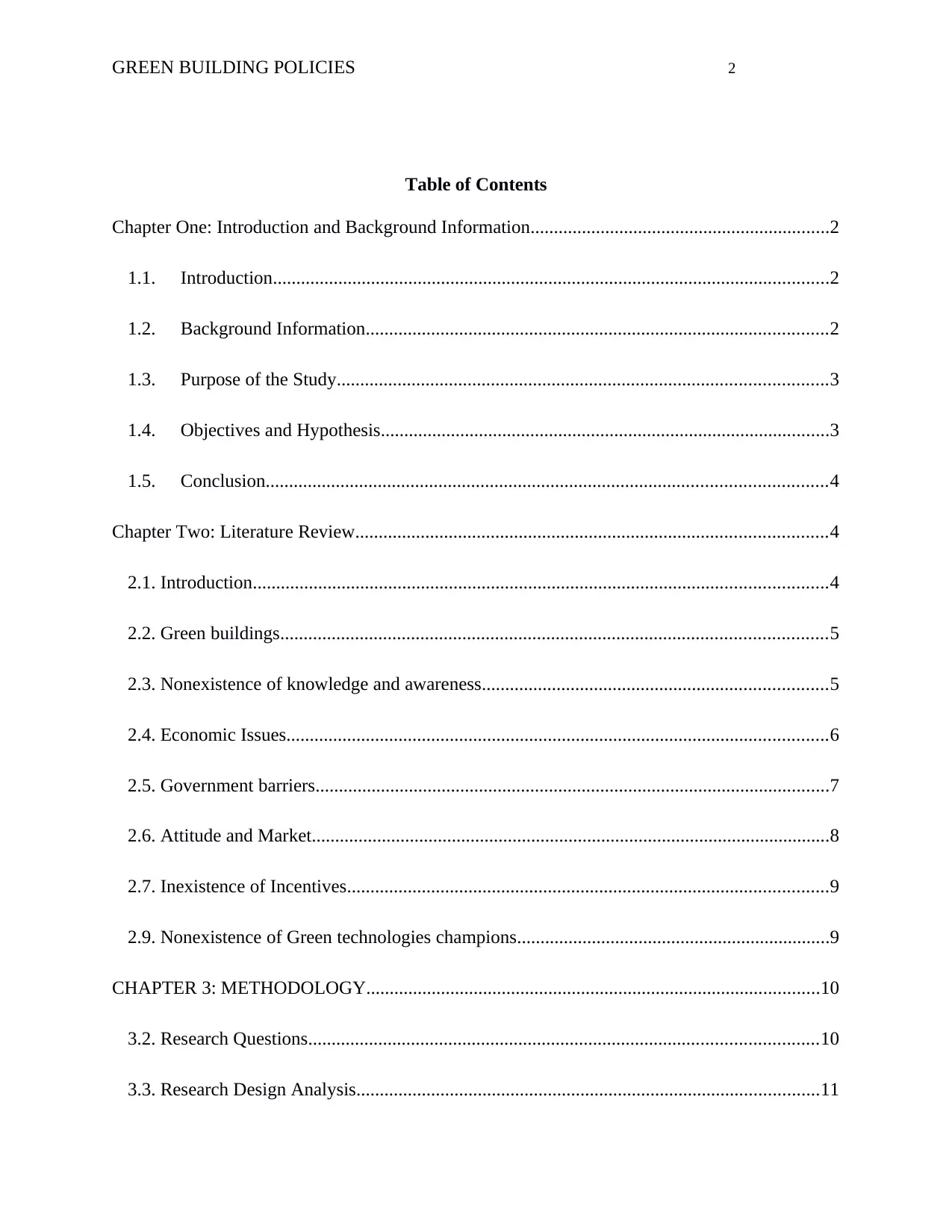
GREEN BUILDING POLICIES 2
Table of Contents
Chapter One: Introduction and Background Information................................................................2
1.1. Introduction.......................................................................................................................2
1.2. Background Information...................................................................................................2
1.3. Purpose of the Study.........................................................................................................3
1.4. Objectives and Hypothesis................................................................................................3
1.5. Conclusion........................................................................................................................4
Chapter Two: Literature Review.....................................................................................................4
2.1. Introduction...........................................................................................................................4
2.2. Green buildings.....................................................................................................................5
2.3. Nonexistence of knowledge and awareness..........................................................................5
2.4. Economic Issues....................................................................................................................6
2.5. Government barriers..............................................................................................................7
2.6. Attitude and Market...............................................................................................................8
2.7. Inexistence of Incentives.......................................................................................................9
2.9. Nonexistence of Green technologies champions...................................................................9
CHAPTER 3: METHODOLOGY.................................................................................................10
3.2. Research Questions.............................................................................................................10
3.3. Research Design Analysis...................................................................................................11
Table of Contents
Chapter One: Introduction and Background Information................................................................2
1.1. Introduction.......................................................................................................................2
1.2. Background Information...................................................................................................2
1.3. Purpose of the Study.........................................................................................................3
1.4. Objectives and Hypothesis................................................................................................3
1.5. Conclusion........................................................................................................................4
Chapter Two: Literature Review.....................................................................................................4
2.1. Introduction...........................................................................................................................4
2.2. Green buildings.....................................................................................................................5
2.3. Nonexistence of knowledge and awareness..........................................................................5
2.4. Economic Issues....................................................................................................................6
2.5. Government barriers..............................................................................................................7
2.6. Attitude and Market...............................................................................................................8
2.7. Inexistence of Incentives.......................................................................................................9
2.9. Nonexistence of Green technologies champions...................................................................9
CHAPTER 3: METHODOLOGY.................................................................................................10
3.2. Research Questions.............................................................................................................10
3.3. Research Design Analysis...................................................................................................11
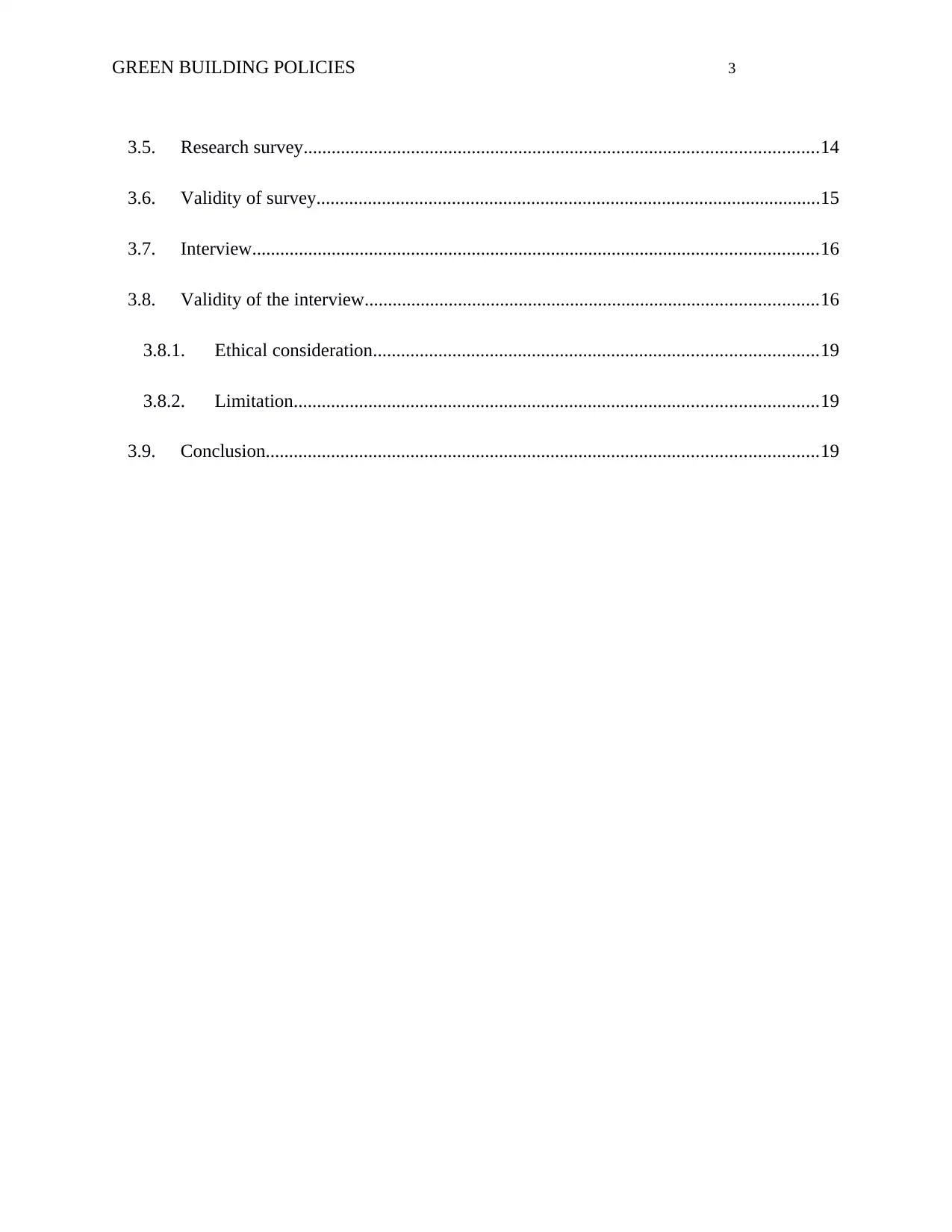
GREEN BUILDING POLICIES 3
3.5. Research survey..............................................................................................................14
3.6. Validity of survey............................................................................................................15
3.7. Interview.........................................................................................................................16
3.8. Validity of the interview.................................................................................................16
3.8.1. Ethical consideration...............................................................................................19
3.8.2. Limitation................................................................................................................19
3.9. Conclusion......................................................................................................................19
3.5. Research survey..............................................................................................................14
3.6. Validity of survey............................................................................................................15
3.7. Interview.........................................................................................................................16
3.8. Validity of the interview.................................................................................................16
3.8.1. Ethical consideration...............................................................................................19
3.8.2. Limitation................................................................................................................19
3.9. Conclusion......................................................................................................................19

GREEN BUILDING POLICIES 4
Chapter One: Introduction and Background Information
1.1. Introduction
The aspect of environmental protection and sustainability has become an integral part of
every industry. Sustainable development is aimed at meeting the needs of the current generation
without compromising the right of the future generation to meet their needs with the same
resource. According to Cooper, Liu, Kosasih, and Yan (2016), there are three essential aspects of
sustainable development. These include the social development, environmental protection, and
economic development. However, green building has been considered as the forth component of
the environment (Tam et al., 2017). Green building (GB) is the process of adopting structures by
the use of processes that consider resource-efficient and environmental responsibility as the
primary goal throughout the life-cycle of the building process (Ciora, Maier & Anghel, 2016). It
covers the construction and design all through to maintenance, operation, deconstruction, and
renovation processes. In the construction industry, green building is gaining an increased
acceptance as a viable solution to achieving the growing demand for a healthy and environmental
friendly building. Also known as the high performance or sustainable buildings, green buildings
consider the comfort, durability, utility element, and economy of a building.
1.2. Background Information
In the current global construction industry, the concept of green building is being adopted
in the global wake of environmental stewardship. With the rise in demand of healthy lifestyles,
the concept of green building is taking a stole whether it is the design of an office or a house.
Chapter One: Introduction and Background Information
1.1. Introduction
The aspect of environmental protection and sustainability has become an integral part of
every industry. Sustainable development is aimed at meeting the needs of the current generation
without compromising the right of the future generation to meet their needs with the same
resource. According to Cooper, Liu, Kosasih, and Yan (2016), there are three essential aspects of
sustainable development. These include the social development, environmental protection, and
economic development. However, green building has been considered as the forth component of
the environment (Tam et al., 2017). Green building (GB) is the process of adopting structures by
the use of processes that consider resource-efficient and environmental responsibility as the
primary goal throughout the life-cycle of the building process (Ciora, Maier & Anghel, 2016). It
covers the construction and design all through to maintenance, operation, deconstruction, and
renovation processes. In the construction industry, green building is gaining an increased
acceptance as a viable solution to achieving the growing demand for a healthy and environmental
friendly building. Also known as the high performance or sustainable buildings, green buildings
consider the comfort, durability, utility element, and economy of a building.
1.2. Background Information
In the current global construction industry, the concept of green building is being adopted
in the global wake of environmental stewardship. With the rise in demand of healthy lifestyles,
the concept of green building is taking a stole whether it is the design of an office or a house.
Secure Best Marks with AI Grader
Need help grading? Try our AI Grader for instant feedback on your assignments.

GREEN BUILDING POLICIES 5
However, there is still limited knowledge on sustainable or green building in the global
construction industry. According to Tam et al. (2017), the adoption of green housing requires
various rating systems for sustainable buildings as they have to meet certain standards to qualify
as green building. As a result, there is a need to take into consideration the initiative and concern
of green building policy adoptions while planning for the process within the industry.
1.3. Purpose of the Study
Cooper et al. (2011) denote that the uptake of GB technology is not as apparent as is
expected in the international construction environment. With the growing interest, there still exist
many barriers that persists in adopting green building policies. The examination of these barriers
is essential is it creates lack of efficiency in the potentiality of the economic and environmental
benefits on the green building policies in the construction industry. Just as important is the
evaluation of issues affecting the adoption of green building policies to effectively foster the
implementation of sustainable building. The main aim of this study is thus to identify common
challenges or barriers to effective policy adoption of initiatives in green building. The paper
evaluates these aspects from the stakeholder perspectives with the aim of proposing effective
recommendations that can be adopted as solutions to the policy challenges identified.
1.4. Objectives
The objective of the research is to examine and evaluate the possible hindrances that need to be
considered to achieve a green policy building. The result will then be a framework highlighting
the obstacles in adopting the green policies with the aim of helping raise awareness on the
importance and benefits of green building and it can promote a healthy lifestyle
However, there is still limited knowledge on sustainable or green building in the global
construction industry. According to Tam et al. (2017), the adoption of green housing requires
various rating systems for sustainable buildings as they have to meet certain standards to qualify
as green building. As a result, there is a need to take into consideration the initiative and concern
of green building policy adoptions while planning for the process within the industry.
1.3. Purpose of the Study
Cooper et al. (2011) denote that the uptake of GB technology is not as apparent as is
expected in the international construction environment. With the growing interest, there still exist
many barriers that persists in adopting green building policies. The examination of these barriers
is essential is it creates lack of efficiency in the potentiality of the economic and environmental
benefits on the green building policies in the construction industry. Just as important is the
evaluation of issues affecting the adoption of green building policies to effectively foster the
implementation of sustainable building. The main aim of this study is thus to identify common
challenges or barriers to effective policy adoption of initiatives in green building. The paper
evaluates these aspects from the stakeholder perspectives with the aim of proposing effective
recommendations that can be adopted as solutions to the policy challenges identified.
1.4. Objectives
The objective of the research is to examine and evaluate the possible hindrances that need to be
considered to achieve a green policy building. The result will then be a framework highlighting
the obstacles in adopting the green policies with the aim of helping raise awareness on the
importance and benefits of green building and it can promote a healthy lifestyle
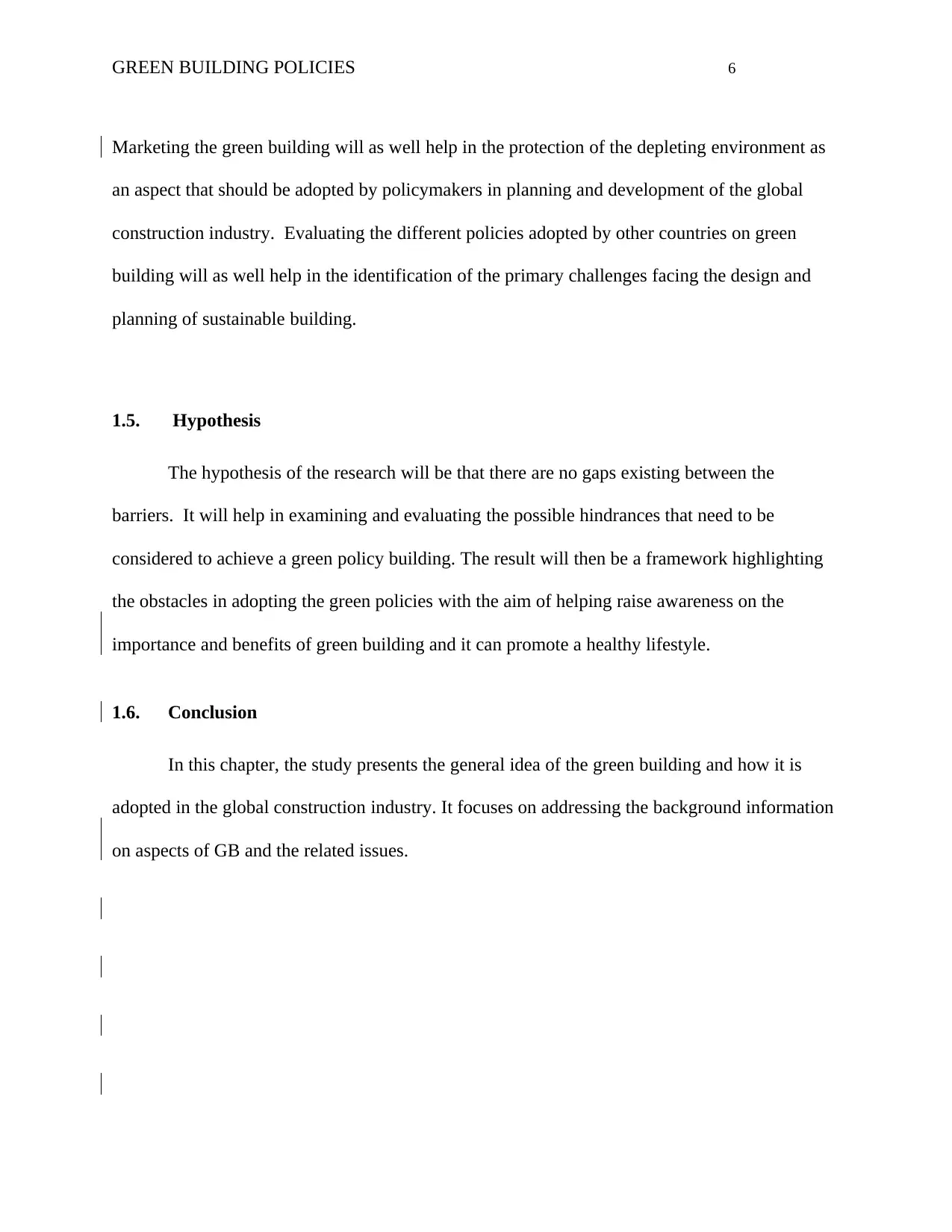
GREEN BUILDING POLICIES 6
Marketing the green building will as well help in the protection of the depleting environment as
an aspect that should be adopted by policymakers in planning and development of the global
construction industry. Evaluating the different policies adopted by other countries on green
building will as well help in the identification of the primary challenges facing the design and
planning of sustainable building.
1.5. Hypothesis
The hypothesis of the research will be that there are no gaps existing between the
barriers. It will help in examining and evaluating the possible hindrances that need to be
considered to achieve a green policy building. The result will then be a framework highlighting
the obstacles in adopting the green policies with the aim of helping raise awareness on the
importance and benefits of green building and it can promote a healthy lifestyle.
1.6. Conclusion
In this chapter, the study presents the general idea of the green building and how it is
adopted in the global construction industry. It focuses on addressing the background information
on aspects of GB and the related issues.
Marketing the green building will as well help in the protection of the depleting environment as
an aspect that should be adopted by policymakers in planning and development of the global
construction industry. Evaluating the different policies adopted by other countries on green
building will as well help in the identification of the primary challenges facing the design and
planning of sustainable building.
1.5. Hypothesis
The hypothesis of the research will be that there are no gaps existing between the
barriers. It will help in examining and evaluating the possible hindrances that need to be
considered to achieve a green policy building. The result will then be a framework highlighting
the obstacles in adopting the green policies with the aim of helping raise awareness on the
importance and benefits of green building and it can promote a healthy lifestyle.
1.6. Conclusion
In this chapter, the study presents the general idea of the green building and how it is
adopted in the global construction industry. It focuses on addressing the background information
on aspects of GB and the related issues.

GREEN BUILDING POLICIES 7
Chapter Two: Literature Review
2.1. Introduction
In this section, we will go through the literature relating to understanding green buildings
and issues regarding adoption of green building policies. As a whole, the issue of adopting the
construction of green buildings comes with a fair share of challenges as they occur in any green
management initiative. According to Visscher, Laubscher, and Chan (2016), barriers that affect
affecting environmental management systems are information scarcity, inadequate information,
inappropriate knowledge, ineffective financial resource management, improper implementation
techniques and harsh organizational culture. The paper is thus focused on pointing out the gaps
that exist in barriers conjoint in the adoption of green building policies. In detail, this chapter
covers the barriers to adoption of green building policies.
Chapter Two: Literature Review
2.1. Introduction
In this section, we will go through the literature relating to understanding green buildings
and issues regarding adoption of green building policies. As a whole, the issue of adopting the
construction of green buildings comes with a fair share of challenges as they occur in any green
management initiative. According to Visscher, Laubscher, and Chan (2016), barriers that affect
affecting environmental management systems are information scarcity, inadequate information,
inappropriate knowledge, ineffective financial resource management, improper implementation
techniques and harsh organizational culture. The paper is thus focused on pointing out the gaps
that exist in barriers conjoint in the adoption of green building policies. In detail, this chapter
covers the barriers to adoption of green building policies.
Paraphrase This Document
Need a fresh take? Get an instant paraphrase of this document with our AI Paraphraser
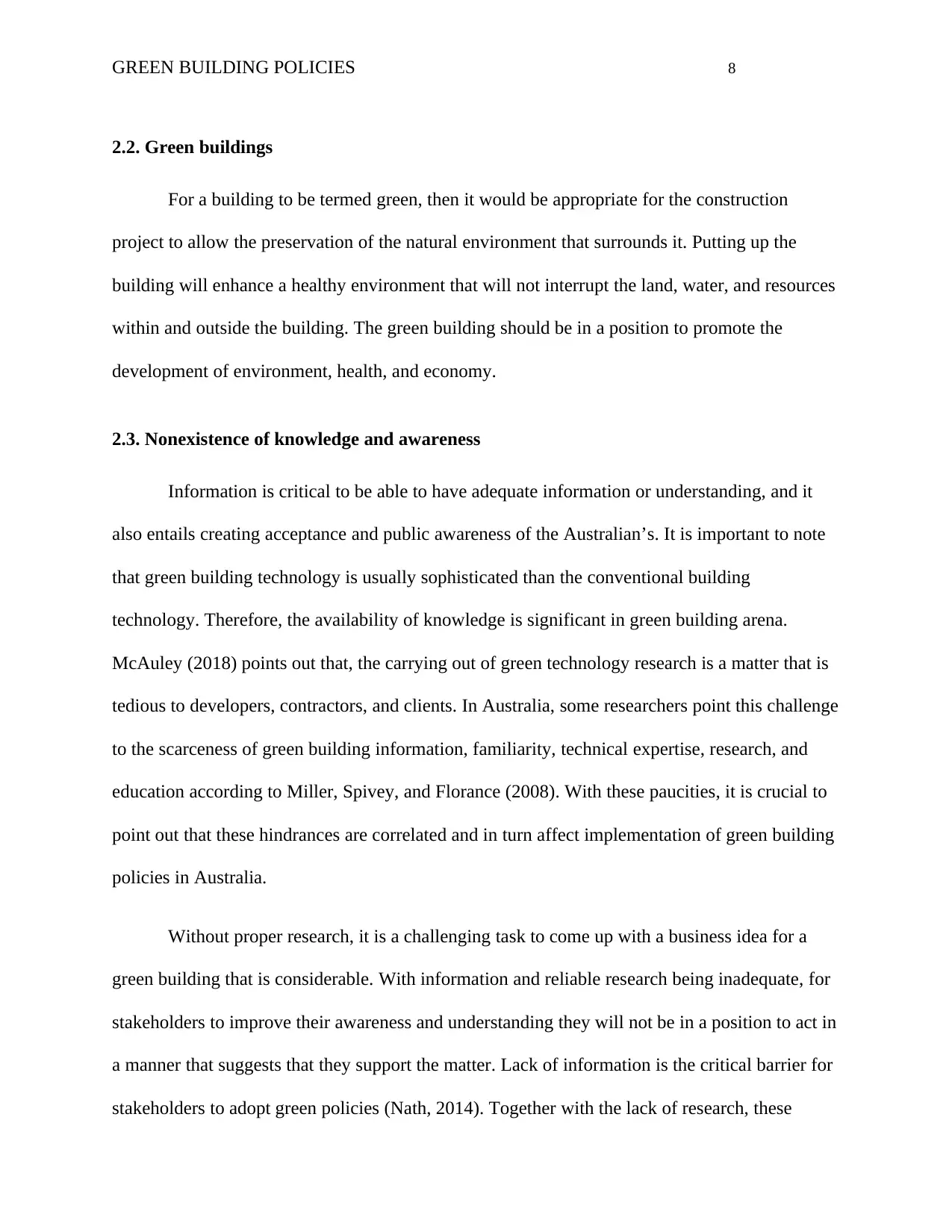
GREEN BUILDING POLICIES 8
2.2. Green buildings
For a building to be termed green, then it would be appropriate for the construction
project to allow the preservation of the natural environment that surrounds it. Putting up the
building will enhance a healthy environment that will not interrupt the land, water, and resources
within and outside the building. The green building should be in a position to promote the
development of environment, health, and economy.
2.3. Nonexistence of knowledge and awareness
Information is critical to be able to have adequate information or understanding, and it
also entails creating acceptance and public awareness of the Australian’s. It is important to note
that green building technology is usually sophisticated than the conventional building
technology. Therefore, the availability of knowledge is significant in green building arena.
McAuley (2018) points out that, the carrying out of green technology research is a matter that is
tedious to developers, contractors, and clients. In Australia, some researchers point this challenge
to the scarceness of green building information, familiarity, technical expertise, research, and
education according to Miller, Spivey, and Florance (2008). With these paucities, it is crucial to
point out that these hindrances are correlated and in turn affect implementation of green building
policies in Australia.
Without proper research, it is a challenging task to come up with a business idea for a
green building that is considerable. With information and reliable research being inadequate, for
stakeholders to improve their awareness and understanding they will not be in a position to act in
a manner that suggests that they support the matter. Lack of information is the critical barrier for
stakeholders to adopt green policies (Nath, 2014). Together with the lack of research, these
2.2. Green buildings
For a building to be termed green, then it would be appropriate for the construction
project to allow the preservation of the natural environment that surrounds it. Putting up the
building will enhance a healthy environment that will not interrupt the land, water, and resources
within and outside the building. The green building should be in a position to promote the
development of environment, health, and economy.
2.3. Nonexistence of knowledge and awareness
Information is critical to be able to have adequate information or understanding, and it
also entails creating acceptance and public awareness of the Australian’s. It is important to note
that green building technology is usually sophisticated than the conventional building
technology. Therefore, the availability of knowledge is significant in green building arena.
McAuley (2018) points out that, the carrying out of green technology research is a matter that is
tedious to developers, contractors, and clients. In Australia, some researchers point this challenge
to the scarceness of green building information, familiarity, technical expertise, research, and
education according to Miller, Spivey, and Florance (2008). With these paucities, it is crucial to
point out that these hindrances are correlated and in turn affect implementation of green building
policies in Australia.
Without proper research, it is a challenging task to come up with a business idea for a
green building that is considerable. With information and reliable research being inadequate, for
stakeholders to improve their awareness and understanding they will not be in a position to act in
a manner that suggests that they support the matter. Lack of information is the critical barrier for
stakeholders to adopt green policies (Nath, 2014). Together with the lack of research, these

GREEN BUILDING POLICIES 9
impact the stakeholders negatively to be able to be aware of the importance of green building
technologies in Australia. Even if investors or the government understand green technologies,
several populations do not understand green technologies making implementing the programs
trying (Hwang, Zhu, Wang, & Cheong, 2017). Improper or lack of understanding may result in
the inappropriate definition of green building and this, in turn, hinders green development in
Australia. Implementing green building guidelines will be a daunting task because stakeholders
will desist from green building adoption reason being, they are not familiar with the green
designs, products, materials and related technologies.
2.4. Economic Issues
Economic or financial concerns are a major hindrance to the adoption of green building
policies leave alone other policies worldwide. During construction of green building projects, the
cost is one of the critical economic factors. When a general comparison is carried out, it costs
more to start and finish green building projects due to its expensive materials compared to the
conventional buildings and such factor translates to their policy adoption. Third party costs
thwart embracing of green building policies (Visscher, 2016). Such third part costs in Australia
include high consultant costs and green building costs. McAuley (2018) denotes that, financial
barriers to green building guidelines include inaccurate perceptions that green building has the
possibility of inviting high initial investments. Economic issues occur in the form that in
Australia, new conventional buildings are increasing at skyrocketing rate, energy prices aren’t
low, and the use of resourceful technologies such as green technologies and renewable
technologies are not efficiently exhilarated.
impact the stakeholders negatively to be able to be aware of the importance of green building
technologies in Australia. Even if investors or the government understand green technologies,
several populations do not understand green technologies making implementing the programs
trying (Hwang, Zhu, Wang, & Cheong, 2017). Improper or lack of understanding may result in
the inappropriate definition of green building and this, in turn, hinders green development in
Australia. Implementing green building guidelines will be a daunting task because stakeholders
will desist from green building adoption reason being, they are not familiar with the green
designs, products, materials and related technologies.
2.4. Economic Issues
Economic or financial concerns are a major hindrance to the adoption of green building
policies leave alone other policies worldwide. During construction of green building projects, the
cost is one of the critical economic factors. When a general comparison is carried out, it costs
more to start and finish green building projects due to its expensive materials compared to the
conventional buildings and such factor translates to their policy adoption. Third party costs
thwart embracing of green building policies (Visscher, 2016). Such third part costs in Australia
include high consultant costs and green building costs. McAuley (2018) denotes that, financial
barriers to green building guidelines include inaccurate perceptions that green building has the
possibility of inviting high initial investments. Economic issues occur in the form that in
Australia, new conventional buildings are increasing at skyrocketing rate, energy prices aren’t
low, and the use of resourceful technologies such as green technologies and renewable
technologies are not efficiently exhilarated.
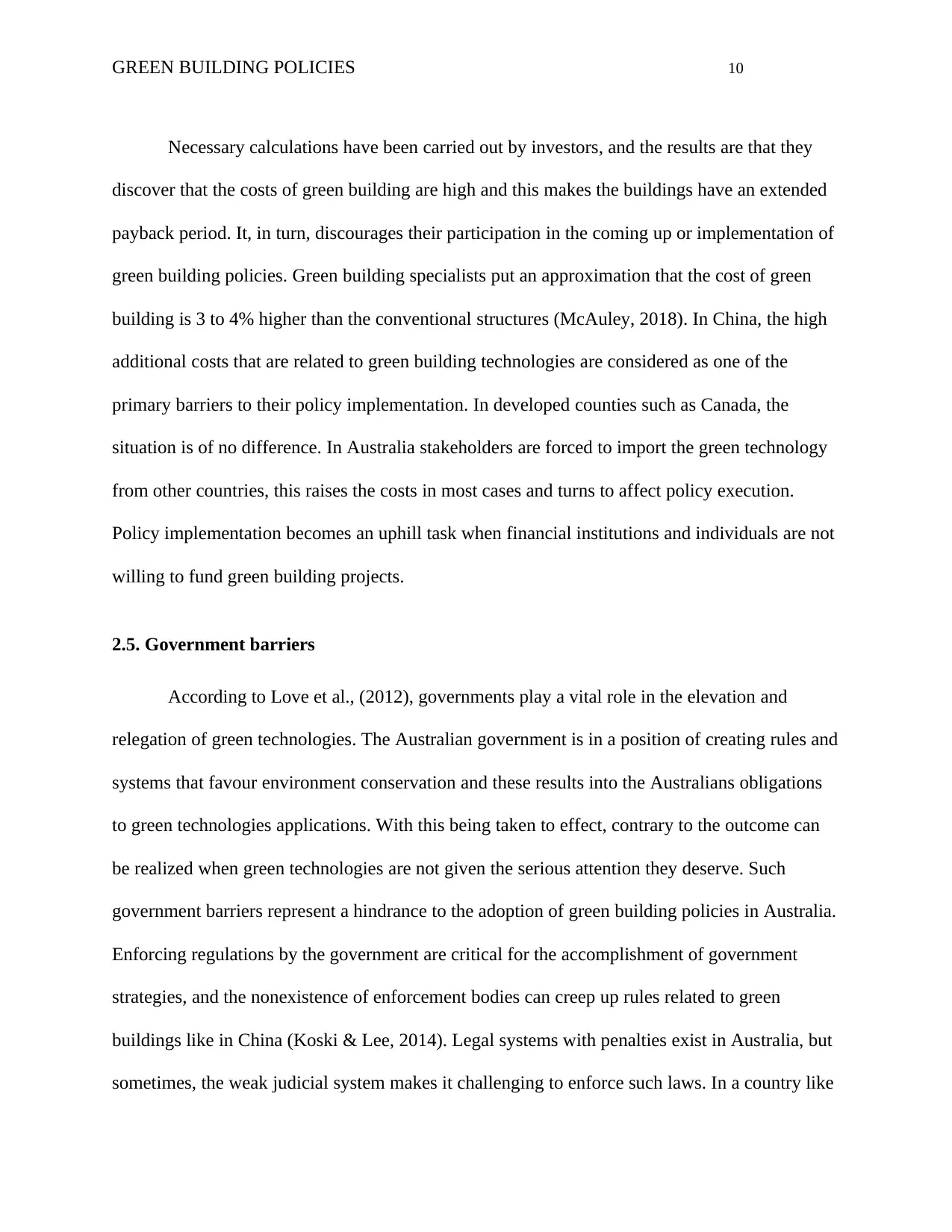
GREEN BUILDING POLICIES 10
Necessary calculations have been carried out by investors, and the results are that they
discover that the costs of green building are high and this makes the buildings have an extended
payback period. It, in turn, discourages their participation in the coming up or implementation of
green building policies. Green building specialists put an approximation that the cost of green
building is 3 to 4% higher than the conventional structures (McAuley, 2018). In China, the high
additional costs that are related to green building technologies are considered as one of the
primary barriers to their policy implementation. In developed counties such as Canada, the
situation is of no difference. In Australia stakeholders are forced to import the green technology
from other countries, this raises the costs in most cases and turns to affect policy execution.
Policy implementation becomes an uphill task when financial institutions and individuals are not
willing to fund green building projects.
2.5. Government barriers
According to Love et al., (2012), governments play a vital role in the elevation and
relegation of green technologies. The Australian government is in a position of creating rules and
systems that favour environment conservation and these results into the Australians obligations
to green technologies applications. With this being taken to effect, contrary to the outcome can
be realized when green technologies are not given the serious attention they deserve. Such
government barriers represent a hindrance to the adoption of green building policies in Australia.
Enforcing regulations by the government are critical for the accomplishment of government
strategies, and the nonexistence of enforcement bodies can creep up rules related to green
buildings like in China (Koski & Lee, 2014). Legal systems with penalties exist in Australia, but
sometimes, the weak judicial system makes it challenging to enforce such laws. In a country like
Necessary calculations have been carried out by investors, and the results are that they
discover that the costs of green building are high and this makes the buildings have an extended
payback period. It, in turn, discourages their participation in the coming up or implementation of
green building policies. Green building specialists put an approximation that the cost of green
building is 3 to 4% higher than the conventional structures (McAuley, 2018). In China, the high
additional costs that are related to green building technologies are considered as one of the
primary barriers to their policy implementation. In developed counties such as Canada, the
situation is of no difference. In Australia stakeholders are forced to import the green technology
from other countries, this raises the costs in most cases and turns to affect policy execution.
Policy implementation becomes an uphill task when financial institutions and individuals are not
willing to fund green building projects.
2.5. Government barriers
According to Love et al., (2012), governments play a vital role in the elevation and
relegation of green technologies. The Australian government is in a position of creating rules and
systems that favour environment conservation and these results into the Australians obligations
to green technologies applications. With this being taken to effect, contrary to the outcome can
be realized when green technologies are not given the serious attention they deserve. Such
government barriers represent a hindrance to the adoption of green building policies in Australia.
Enforcing regulations by the government are critical for the accomplishment of government
strategies, and the nonexistence of enforcement bodies can creep up rules related to green
buildings like in China (Koski & Lee, 2014). Legal systems with penalties exist in Australia, but
sometimes, the weak judicial system makes it challenging to enforce such laws. In a country like
Secure Best Marks with AI Grader
Need help grading? Try our AI Grader for instant feedback on your assignments.
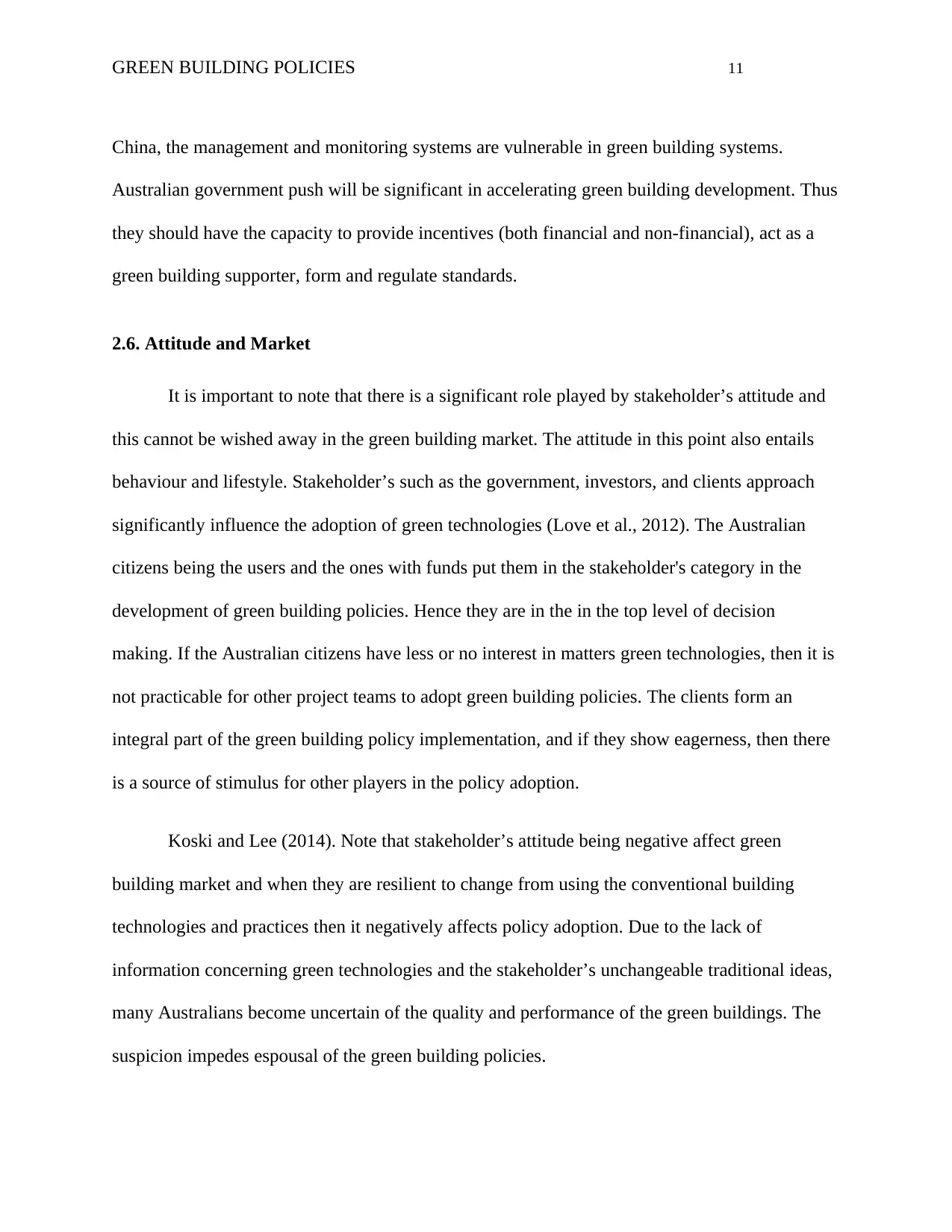
GREEN BUILDING POLICIES 11
China, the management and monitoring systems are vulnerable in green building systems.
Australian government push will be significant in accelerating green building development. Thus
they should have the capacity to provide incentives (both financial and non-financial), act as a
green building supporter, form and regulate standards.
2.6. Attitude and Market
It is important to note that there is a significant role played by stakeholder’s attitude and
this cannot be wished away in the green building market. The attitude in this point also entails
behaviour and lifestyle. Stakeholder’s such as the government, investors, and clients approach
significantly influence the adoption of green technologies (Love et al., 2012). The Australian
citizens being the users and the ones with funds put them in the stakeholder's category in the
development of green building policies. Hence they are in the in the top level of decision
making. If the Australian citizens have less or no interest in matters green technologies, then it is
not practicable for other project teams to adopt green building policies. The clients form an
integral part of the green building policy implementation, and if they show eagerness, then there
is a source of stimulus for other players in the policy adoption.
Koski and Lee (2014). Note that stakeholder’s attitude being negative affect green
building market and when they are resilient to change from using the conventional building
technologies and practices then it negatively affects policy adoption. Due to the lack of
information concerning green technologies and the stakeholder’s unchangeable traditional ideas,
many Australians become uncertain of the quality and performance of the green buildings. The
suspicion impedes espousal of the green building policies.
China, the management and monitoring systems are vulnerable in green building systems.
Australian government push will be significant in accelerating green building development. Thus
they should have the capacity to provide incentives (both financial and non-financial), act as a
green building supporter, form and regulate standards.
2.6. Attitude and Market
It is important to note that there is a significant role played by stakeholder’s attitude and
this cannot be wished away in the green building market. The attitude in this point also entails
behaviour and lifestyle. Stakeholder’s such as the government, investors, and clients approach
significantly influence the adoption of green technologies (Love et al., 2012). The Australian
citizens being the users and the ones with funds put them in the stakeholder's category in the
development of green building policies. Hence they are in the in the top level of decision
making. If the Australian citizens have less or no interest in matters green technologies, then it is
not practicable for other project teams to adopt green building policies. The clients form an
integral part of the green building policy implementation, and if they show eagerness, then there
is a source of stimulus for other players in the policy adoption.
Koski and Lee (2014). Note that stakeholder’s attitude being negative affect green
building market and when they are resilient to change from using the conventional building
technologies and practices then it negatively affects policy adoption. Due to the lack of
information concerning green technologies and the stakeholder’s unchangeable traditional ideas,
many Australians become uncertain of the quality and performance of the green buildings. The
suspicion impedes espousal of the green building policies.
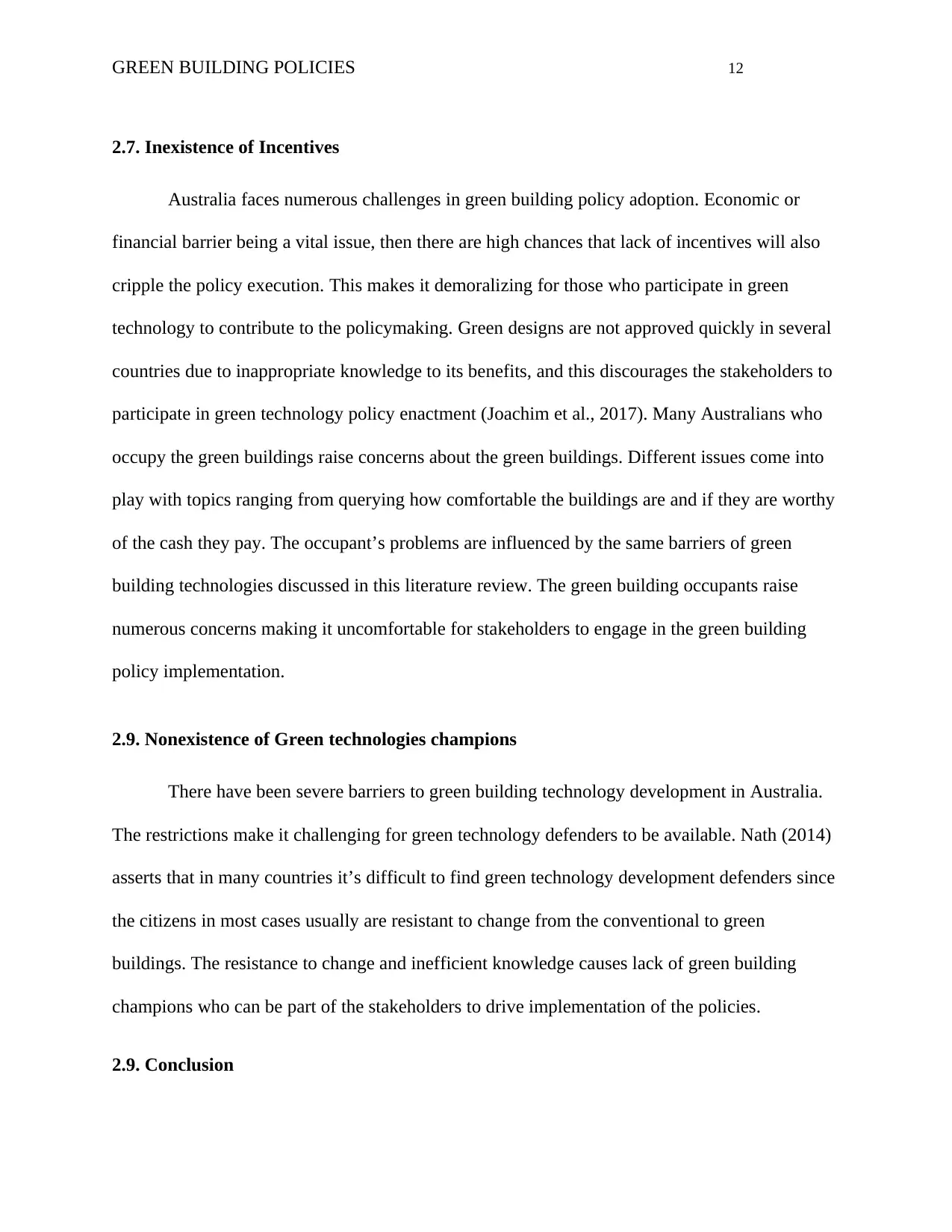
GREEN BUILDING POLICIES 12
2.7. Inexistence of Incentives
Australia faces numerous challenges in green building policy adoption. Economic or
financial barrier being a vital issue, then there are high chances that lack of incentives will also
cripple the policy execution. This makes it demoralizing for those who participate in green
technology to contribute to the policymaking. Green designs are not approved quickly in several
countries due to inappropriate knowledge to its benefits, and this discourages the stakeholders to
participate in green technology policy enactment (Joachim et al., 2017). Many Australians who
occupy the green buildings raise concerns about the green buildings. Different issues come into
play with topics ranging from querying how comfortable the buildings are and if they are worthy
of the cash they pay. The occupant’s problems are influenced by the same barriers of green
building technologies discussed in this literature review. The green building occupants raise
numerous concerns making it uncomfortable for stakeholders to engage in the green building
policy implementation.
2.9. Nonexistence of Green technologies champions
There have been severe barriers to green building technology development in Australia.
The restrictions make it challenging for green technology defenders to be available. Nath (2014)
asserts that in many countries it’s difficult to find green technology development defenders since
the citizens in most cases usually are resistant to change from the conventional to green
buildings. The resistance to change and inefficient knowledge causes lack of green building
champions who can be part of the stakeholders to drive implementation of the policies.
2.9. Conclusion
2.7. Inexistence of Incentives
Australia faces numerous challenges in green building policy adoption. Economic or
financial barrier being a vital issue, then there are high chances that lack of incentives will also
cripple the policy execution. This makes it demoralizing for those who participate in green
technology to contribute to the policymaking. Green designs are not approved quickly in several
countries due to inappropriate knowledge to its benefits, and this discourages the stakeholders to
participate in green technology policy enactment (Joachim et al., 2017). Many Australians who
occupy the green buildings raise concerns about the green buildings. Different issues come into
play with topics ranging from querying how comfortable the buildings are and if they are worthy
of the cash they pay. The occupant’s problems are influenced by the same barriers of green
building technologies discussed in this literature review. The green building occupants raise
numerous concerns making it uncomfortable for stakeholders to engage in the green building
policy implementation.
2.9. Nonexistence of Green technologies champions
There have been severe barriers to green building technology development in Australia.
The restrictions make it challenging for green technology defenders to be available. Nath (2014)
asserts that in many countries it’s difficult to find green technology development defenders since
the citizens in most cases usually are resistant to change from the conventional to green
buildings. The resistance to change and inefficient knowledge causes lack of green building
champions who can be part of the stakeholders to drive implementation of the policies.
2.9. Conclusion

GREEN BUILDING POLICIES 13
Australia faces the task of developing its economy and protecting its ecological
environment is on top of its priorities. Green buildings have the capabilities to diminish the
negative impact of constructing buildings on the natural environment. The adoption of green
building policies is affected by many barriers. Australia faces numerous obstacles to adoption of
green building policies. This literature review aimed at analysing the problems in adoption of
green building policies in Australia. With the comparison of different experts and journals, most
of the barriers explained in this review are found to be critical. The barriers that are most critical
include non-existence of knowledge, financial issues, government barriers, attitude, and market.
CHAPTER 3: METHODOLOGY
This section will evaluate the methodological design that will be adopted by the study. It
presents the hypothesis and research questions that will guide the research towards finding
objectives related to the research. It also focuses on the instrumentation as well as related factors
that directly or indirectly affect the study process.
3.1. Hypotheses
The research examines the following hypotheses:
1. The role of economic costs and market prices on the adoption of GB technology
Australia faces the task of developing its economy and protecting its ecological
environment is on top of its priorities. Green buildings have the capabilities to diminish the
negative impact of constructing buildings on the natural environment. The adoption of green
building policies is affected by many barriers. Australia faces numerous obstacles to adoption of
green building policies. This literature review aimed at analysing the problems in adoption of
green building policies in Australia. With the comparison of different experts and journals, most
of the barriers explained in this review are found to be critical. The barriers that are most critical
include non-existence of knowledge, financial issues, government barriers, attitude, and market.
CHAPTER 3: METHODOLOGY
This section will evaluate the methodological design that will be adopted by the study. It
presents the hypothesis and research questions that will guide the research towards finding
objectives related to the research. It also focuses on the instrumentation as well as related factors
that directly or indirectly affect the study process.
3.1. Hypotheses
The research examines the following hypotheses:
1. The role of economic costs and market prices on the adoption of GB technology
Paraphrase This Document
Need a fresh take? Get an instant paraphrase of this document with our AI Paraphraser

GREEN BUILDING POLICIES 14
2. Unwillingness to change and lack of interest in new techniques is the reason for slow
adaptation of the GB technology
3. Inadequate government incentives to promote GB technology is the main reason for its
slow prevalence in the country
4. There are no sufficient GB data base information
3.2. Research Questions
1. From your assessment how many horticultural farmers do you think are knowledgeable
about GB technology
2. Do we have enough training facilities to impart GB technology knowledge on our
horticultural farmers?
3. Are the available research and training facilities on GB technology reliable?
4. Do you think the government has done enough to promote the adoption of GB
technology?
5. Has the agricultural research and development been sufficient to promote GB
technology?
6. Do you think government policies on GB technology promote its adoption or undermine
it?
7. Do you think an average farmer can afford to installation of GB technology?
8. How does time affects the implementation GB technology?
9. Do we have sufficient GB rating systems
10. How complex is implantation of GB technology
2. Unwillingness to change and lack of interest in new techniques is the reason for slow
adaptation of the GB technology
3. Inadequate government incentives to promote GB technology is the main reason for its
slow prevalence in the country
4. There are no sufficient GB data base information
3.2. Research Questions
1. From your assessment how many horticultural farmers do you think are knowledgeable
about GB technology
2. Do we have enough training facilities to impart GB technology knowledge on our
horticultural farmers?
3. Are the available research and training facilities on GB technology reliable?
4. Do you think the government has done enough to promote the adoption of GB
technology?
5. Has the agricultural research and development been sufficient to promote GB
technology?
6. Do you think government policies on GB technology promote its adoption or undermine
it?
7. Do you think an average farmer can afford to installation of GB technology?
8. How does time affects the implementation GB technology?
9. Do we have sufficient GB rating systems
10. How complex is implantation of GB technology
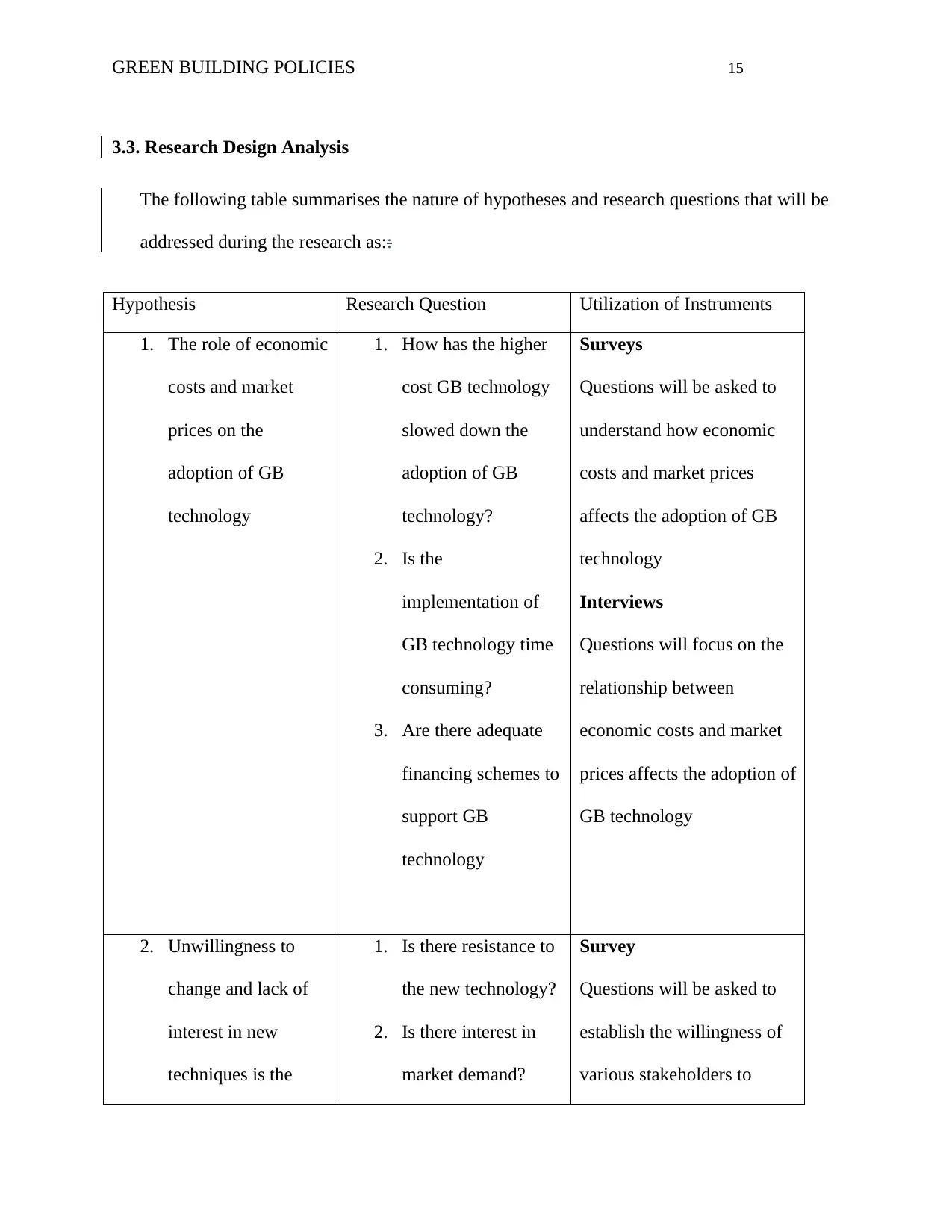
GREEN BUILDING POLICIES 15
3.3. Research Design Analysis
The following table summarises the nature of hypotheses and research questions that will be
addressed during the research as::
Hypothesis Research Question Utilization of Instruments
1. The role of economic
costs and market
prices on the
adoption of GB
technology
1. How has the higher
cost GB technology
slowed down the
adoption of GB
technology?
2. Is the
implementation of
GB technology time
consuming?
3. Are there adequate
financing schemes to
support GB
technology
Surveys
Questions will be asked to
understand how economic
costs and market prices
affects the adoption of GB
technology
Interviews
Questions will focus on the
relationship between
economic costs and market
prices affects the adoption of
GB technology
2. Unwillingness to
change and lack of
interest in new
techniques is the
1. Is there resistance to
the new technology?
2. Is there interest in
market demand?
Survey
Questions will be asked to
establish the willingness of
various stakeholders to
3.3. Research Design Analysis
The following table summarises the nature of hypotheses and research questions that will be
addressed during the research as::
Hypothesis Research Question Utilization of Instruments
1. The role of economic
costs and market
prices on the
adoption of GB
technology
1. How has the higher
cost GB technology
slowed down the
adoption of GB
technology?
2. Is the
implementation of
GB technology time
consuming?
3. Are there adequate
financing schemes to
support GB
technology
Surveys
Questions will be asked to
understand how economic
costs and market prices
affects the adoption of GB
technology
Interviews
Questions will focus on the
relationship between
economic costs and market
prices affects the adoption of
GB technology
2. Unwillingness to
change and lack of
interest in new
techniques is the
1. Is there resistance to
the new technology?
2. Is there interest in
market demand?
Survey
Questions will be asked to
establish the willingness of
various stakeholders to
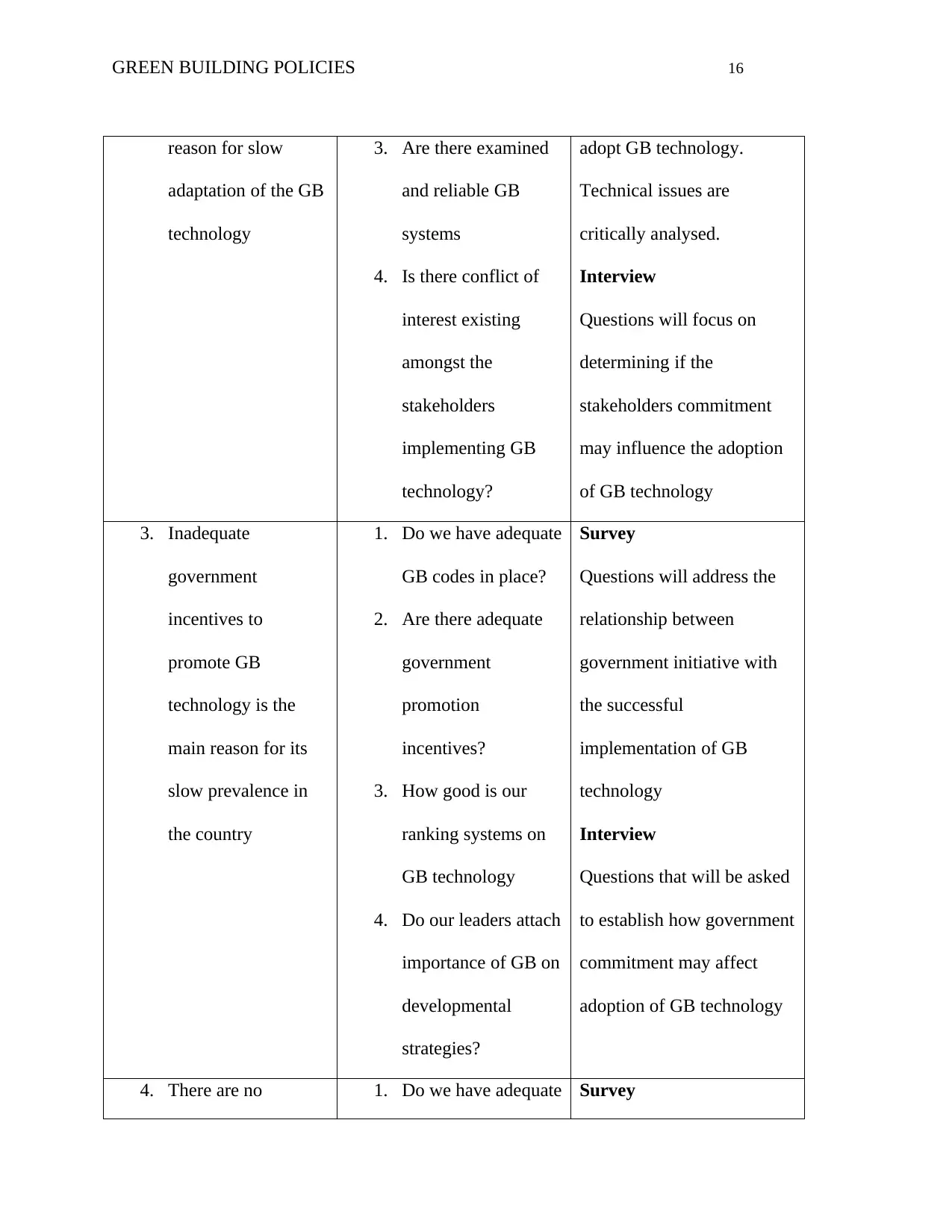
GREEN BUILDING POLICIES 16
reason for slow
adaptation of the GB
technology
3. Are there examined
and reliable GB
systems
4. Is there conflict of
interest existing
amongst the
stakeholders
implementing GB
technology?
adopt GB technology.
Technical issues are
critically analysed.
Interview
Questions will focus on
determining if the
stakeholders commitment
may influence the adoption
of GB technology
3. Inadequate
government
incentives to
promote GB
technology is the
main reason for its
slow prevalence in
the country
1. Do we have adequate
GB codes in place?
2. Are there adequate
government
promotion
incentives?
3. How good is our
ranking systems on
GB technology
4. Do our leaders attach
importance of GB on
developmental
strategies?
Survey
Questions will address the
relationship between
government initiative with
the successful
implementation of GB
technology
Interview
Questions that will be asked
to establish how government
commitment may affect
adoption of GB technology
4. There are no 1. Do we have adequate Survey
reason for slow
adaptation of the GB
technology
3. Are there examined
and reliable GB
systems
4. Is there conflict of
interest existing
amongst the
stakeholders
implementing GB
technology?
adopt GB technology.
Technical issues are
critically analysed.
Interview
Questions will focus on
determining if the
stakeholders commitment
may influence the adoption
of GB technology
3. Inadequate
government
incentives to
promote GB
technology is the
main reason for its
slow prevalence in
the country
1. Do we have adequate
GB codes in place?
2. Are there adequate
government
promotion
incentives?
3. How good is our
ranking systems on
GB technology
4. Do our leaders attach
importance of GB on
developmental
strategies?
Survey
Questions will address the
relationship between
government initiative with
the successful
implementation of GB
technology
Interview
Questions that will be asked
to establish how government
commitment may affect
adoption of GB technology
4. There are no 1. Do we have adequate Survey
Secure Best Marks with AI Grader
Need help grading? Try our AI Grader for instant feedback on your assignments.
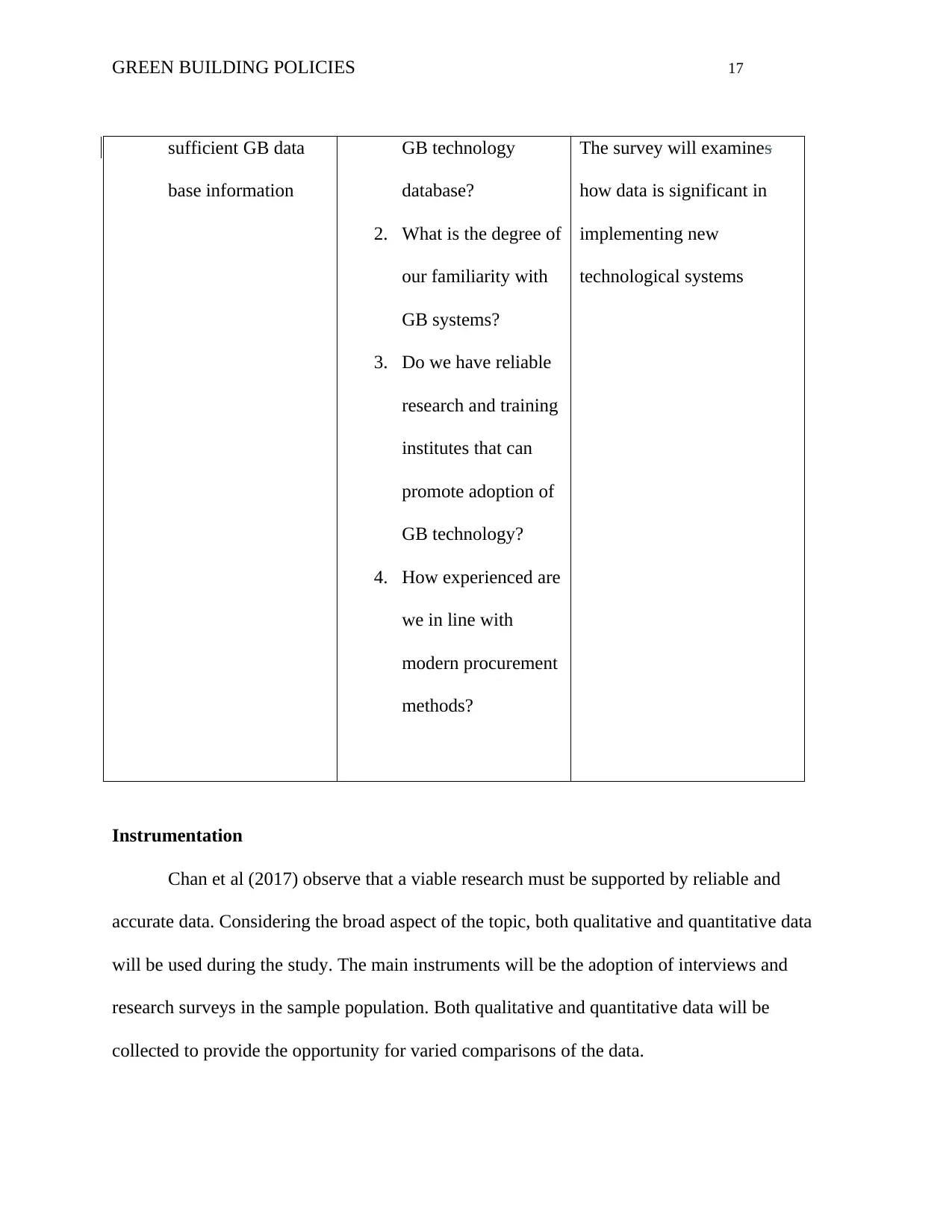
GREEN BUILDING POLICIES 17
sufficient GB data
base information
GB technology
database?
2. What is the degree of
our familiarity with
GB systems?
3. Do we have reliable
research and training
institutes that can
promote adoption of
GB technology?
4. How experienced are
we in line with
modern procurement
methods?
The survey will examines
how data is significant in
implementing new
technological systems
Instrumentation
Chan et al (2017) observe that a viable research must be supported by reliable and
accurate data. Considering the broad aspect of the topic, both qualitative and quantitative data
will be used during the study. The main instruments will be the adoption of interviews and
research surveys in the sample population. Both qualitative and quantitative data will be
collected to provide the opportunity for varied comparisons of the data.
sufficient GB data
base information
GB technology
database?
2. What is the degree of
our familiarity with
GB systems?
3. Do we have reliable
research and training
institutes that can
promote adoption of
GB technology?
4. How experienced are
we in line with
modern procurement
methods?
The survey will examines
how data is significant in
implementing new
technological systems
Instrumentation
Chan et al (2017) observe that a viable research must be supported by reliable and
accurate data. Considering the broad aspect of the topic, both qualitative and quantitative data
will be used during the study. The main instruments will be the adoption of interviews and
research surveys in the sample population. Both qualitative and quantitative data will be
collected to provide the opportunity for varied comparisons of the data.
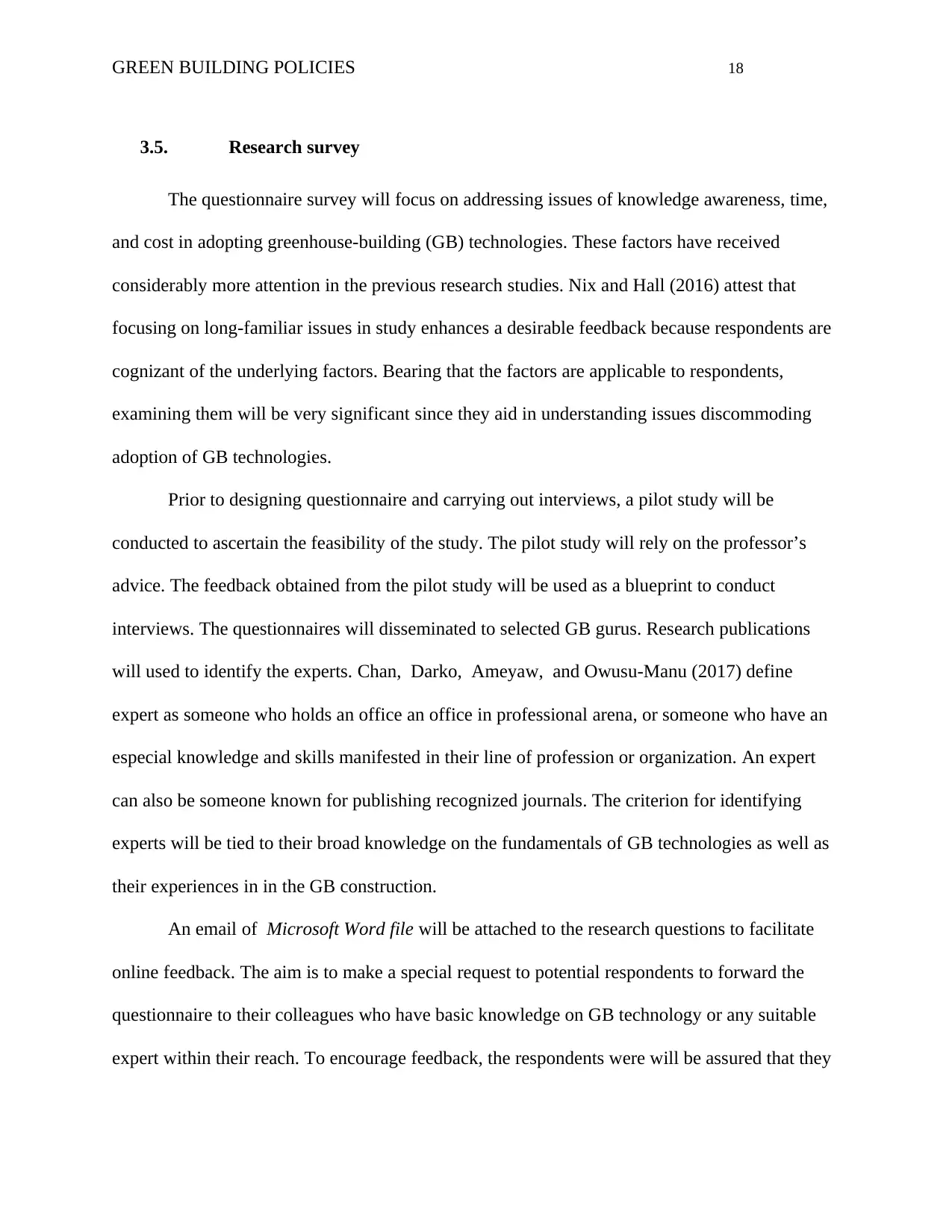
GREEN BUILDING POLICIES 18
3.5. Research survey
The questionnaire survey will focus on addressing issues of knowledge awareness, time,
and cost in adopting greenhouse-building (GB) technologies. These factors have received
considerably more attention in the previous research studies. Nix and Hall (2016) attest that
focusing on long-familiar issues in study enhances a desirable feedback because respondents are
cognizant of the underlying factors. Bearing that the factors are applicable to respondents,
examining them will be very significant since they aid in understanding issues discommoding
adoption of GB technologies.
Prior to designing questionnaire and carrying out interviews, a pilot study will be
conducted to ascertain the feasibility of the study. The pilot study will rely on the professor’s
advice. The feedback obtained from the pilot study will be used as a blueprint to conduct
interviews. The questionnaires will disseminated to selected GB gurus. Research publications
will used to identify the experts. Chan, Darko, Ameyaw, and Owusu-Manu (2017) define
expert as someone who holds an office an office in professional arena, or someone who have an
especial knowledge and skills manifested in their line of profession or organization. An expert
can also be someone known for publishing recognized journals. The criterion for identifying
experts will be tied to their broad knowledge on the fundamentals of GB technologies as well as
their experiences in in the GB construction.
An email of Microsoft Word file will be attached to the research questions to facilitate
online feedback. The aim is to make a special request to potential respondents to forward the
questionnaire to their colleagues who have basic knowledge on GB technology or any suitable
expert within their reach. To encourage feedback, the respondents were will be assured that they
3.5. Research survey
The questionnaire survey will focus on addressing issues of knowledge awareness, time,
and cost in adopting greenhouse-building (GB) technologies. These factors have received
considerably more attention in the previous research studies. Nix and Hall (2016) attest that
focusing on long-familiar issues in study enhances a desirable feedback because respondents are
cognizant of the underlying factors. Bearing that the factors are applicable to respondents,
examining them will be very significant since they aid in understanding issues discommoding
adoption of GB technologies.
Prior to designing questionnaire and carrying out interviews, a pilot study will be
conducted to ascertain the feasibility of the study. The pilot study will rely on the professor’s
advice. The feedback obtained from the pilot study will be used as a blueprint to conduct
interviews. The questionnaires will disseminated to selected GB gurus. Research publications
will used to identify the experts. Chan, Darko, Ameyaw, and Owusu-Manu (2017) define
expert as someone who holds an office an office in professional arena, or someone who have an
especial knowledge and skills manifested in their line of profession or organization. An expert
can also be someone known for publishing recognized journals. The criterion for identifying
experts will be tied to their broad knowledge on the fundamentals of GB technologies as well as
their experiences in in the GB construction.
An email of Microsoft Word file will be attached to the research questions to facilitate
online feedback. The aim is to make a special request to potential respondents to forward the
questionnaire to their colleagues who have basic knowledge on GB technology or any suitable
expert within their reach. To encourage feedback, the respondents were will be assured that they
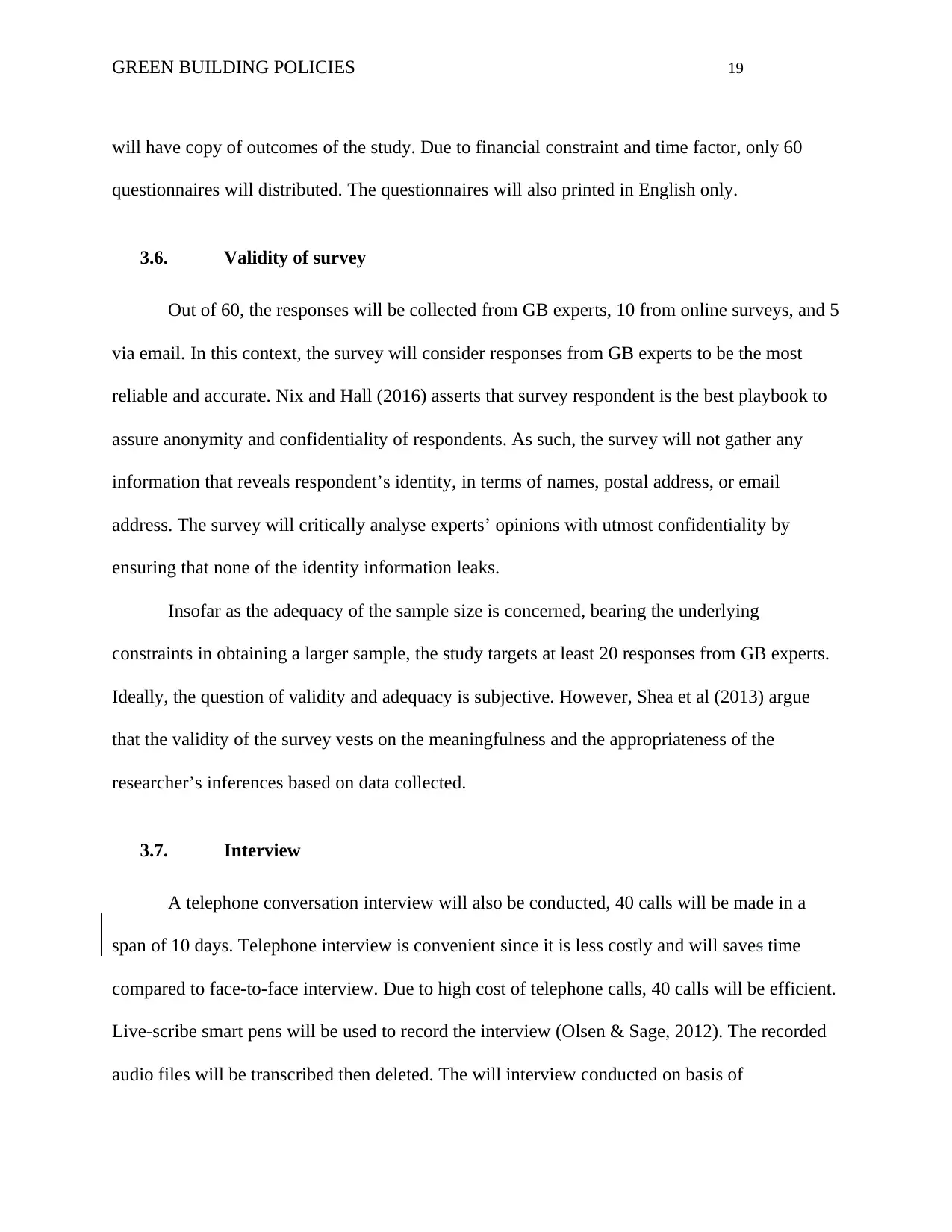
GREEN BUILDING POLICIES 19
will have copy of outcomes of the study. Due to financial constraint and time factor, only 60
questionnaires will distributed. The questionnaires will also printed in English only.
3.6. Validity of survey
Out of 60, the responses will be collected from GB experts, 10 from online surveys, and 5
via email. In this context, the survey will consider responses from GB experts to be the most
reliable and accurate. Nix and Hall (2016) asserts that survey respondent is the best playbook to
assure anonymity and confidentiality of respondents. As such, the survey will not gather any
information that reveals respondent’s identity, in terms of names, postal address, or email
address. The survey will critically analyse experts’ opinions with utmost confidentiality by
ensuring that none of the identity information leaks.
Insofar as the adequacy of the sample size is concerned, bearing the underlying
constraints in obtaining a larger sample, the study targets at least 20 responses from GB experts.
Ideally, the question of validity and adequacy is subjective. However, Shea et al (2013) argue
that the validity of the survey vests on the meaningfulness and the appropriateness of the
researcher’s inferences based on data collected.
3.7. Interview
A telephone conversation interview will also be conducted, 40 calls will be made in a
span of 10 days. Telephone interview is convenient since it is less costly and will saves time
compared to face-to-face interview. Due to high cost of telephone calls, 40 calls will be efficient.
Live-scribe smart pens will be used to record the interview (Olsen & Sage, 2012). The recorded
audio files will be transcribed then deleted. The will interview conducted on basis of
will have copy of outcomes of the study. Due to financial constraint and time factor, only 60
questionnaires will distributed. The questionnaires will also printed in English only.
3.6. Validity of survey
Out of 60, the responses will be collected from GB experts, 10 from online surveys, and 5
via email. In this context, the survey will consider responses from GB experts to be the most
reliable and accurate. Nix and Hall (2016) asserts that survey respondent is the best playbook to
assure anonymity and confidentiality of respondents. As such, the survey will not gather any
information that reveals respondent’s identity, in terms of names, postal address, or email
address. The survey will critically analyse experts’ opinions with utmost confidentiality by
ensuring that none of the identity information leaks.
Insofar as the adequacy of the sample size is concerned, bearing the underlying
constraints in obtaining a larger sample, the study targets at least 20 responses from GB experts.
Ideally, the question of validity and adequacy is subjective. However, Shea et al (2013) argue
that the validity of the survey vests on the meaningfulness and the appropriateness of the
researcher’s inferences based on data collected.
3.7. Interview
A telephone conversation interview will also be conducted, 40 calls will be made in a
span of 10 days. Telephone interview is convenient since it is less costly and will saves time
compared to face-to-face interview. Due to high cost of telephone calls, 40 calls will be efficient.
Live-scribe smart pens will be used to record the interview (Olsen & Sage, 2012). The recorded
audio files will be transcribed then deleted. The will interview conducted on basis of
Paraphrase This Document
Need a fresh take? Get an instant paraphrase of this document with our AI Paraphraser
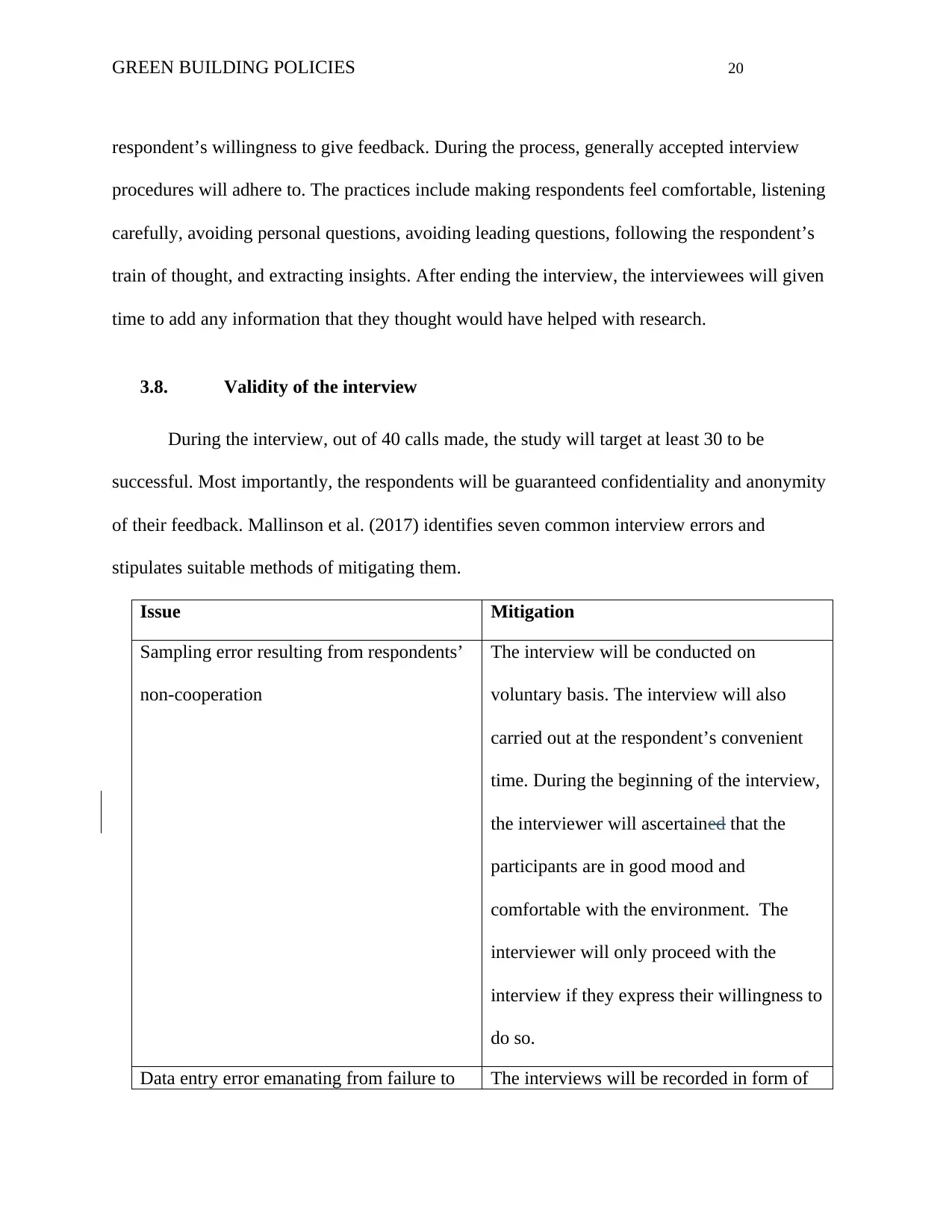
GREEN BUILDING POLICIES 20
respondent’s willingness to give feedback. During the process, generally accepted interview
procedures will adhere to. The practices include making respondents feel comfortable, listening
carefully, avoiding personal questions, avoiding leading questions, following the respondent’s
train of thought, and extracting insights. After ending the interview, the interviewees will given
time to add any information that they thought would have helped with research.
3.8. Validity of the interview
During the interview, out of 40 calls made, the study will target at least 30 to be
successful. Most importantly, the respondents will be guaranteed confidentiality and anonymity
of their feedback. Mallinson et al. (2017) identifies seven common interview errors and
stipulates suitable methods of mitigating them.
Issue Mitigation
Sampling error resulting from respondents’
non-cooperation
The interview will be conducted on
voluntary basis. The interview will also
carried out at the respondent’s convenient
time. During the beginning of the interview,
the interviewer will ascertained that the
participants are in good mood and
comfortable with the environment. The
interviewer will only proceed with the
interview if they express their willingness to
do so.
Data entry error emanating from failure to The interviews will be recorded in form of
respondent’s willingness to give feedback. During the process, generally accepted interview
procedures will adhere to. The practices include making respondents feel comfortable, listening
carefully, avoiding personal questions, avoiding leading questions, following the respondent’s
train of thought, and extracting insights. After ending the interview, the interviewees will given
time to add any information that they thought would have helped with research.
3.8. Validity of the interview
During the interview, out of 40 calls made, the study will target at least 30 to be
successful. Most importantly, the respondents will be guaranteed confidentiality and anonymity
of their feedback. Mallinson et al. (2017) identifies seven common interview errors and
stipulates suitable methods of mitigating them.
Issue Mitigation
Sampling error resulting from respondents’
non-cooperation
The interview will be conducted on
voluntary basis. The interview will also
carried out at the respondent’s convenient
time. During the beginning of the interview,
the interviewer will ascertained that the
participants are in good mood and
comfortable with the environment. The
interviewer will only proceed with the
interview if they express their willingness to
do so.
Data entry error emanating from failure to The interviews will be recorded in form of
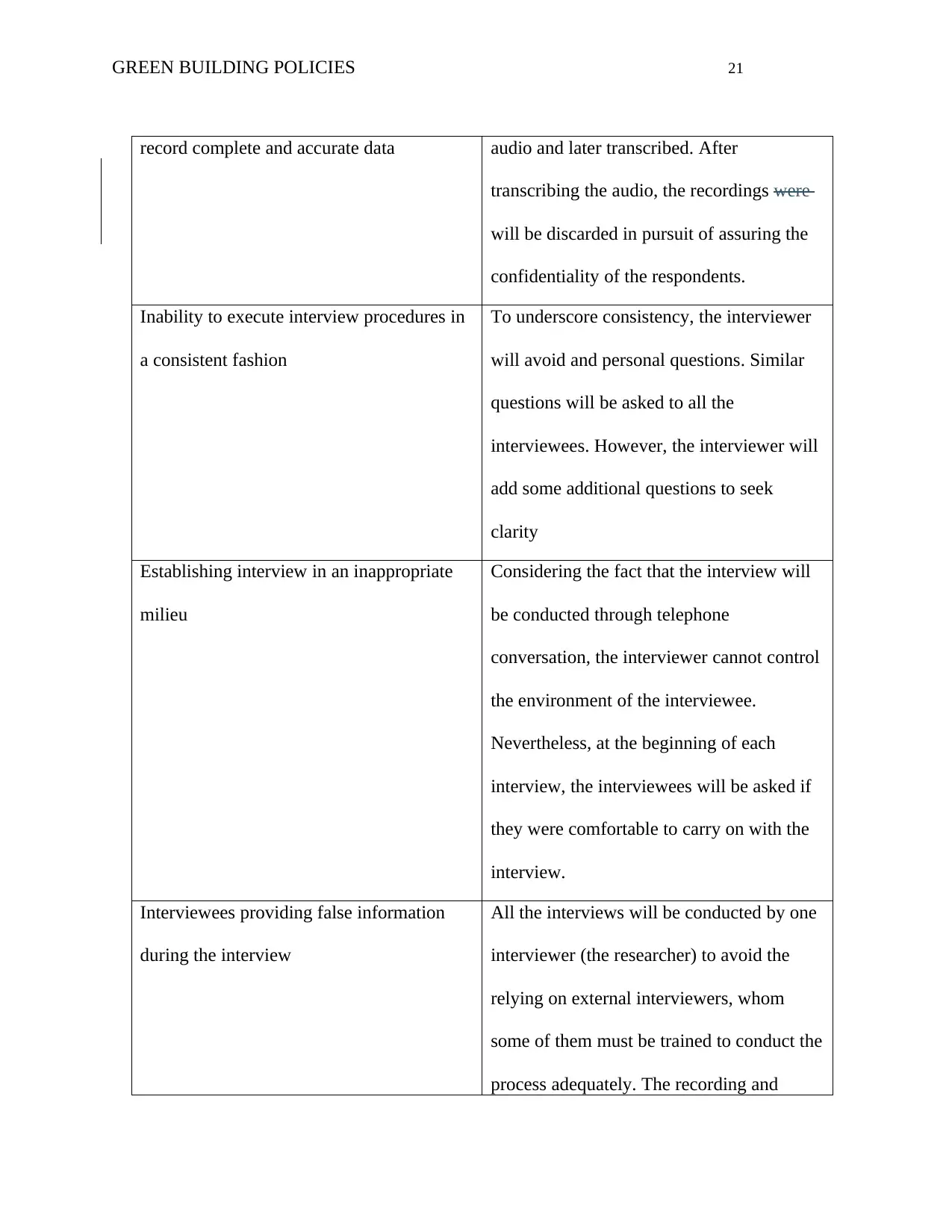
GREEN BUILDING POLICIES 21
record complete and accurate data audio and later transcribed. After
transcribing the audio, the recordings were
will be discarded in pursuit of assuring the
confidentiality of the respondents.
Inability to execute interview procedures in
a consistent fashion
To underscore consistency, the interviewer
will avoid and personal questions. Similar
questions will be asked to all the
interviewees. However, the interviewer will
add some additional questions to seek
clarity
Establishing interview in an inappropriate
milieu
Considering the fact that the interview will
be conducted through telephone
conversation, the interviewer cannot control
the environment of the interviewee.
Nevertheless, at the beginning of each
interview, the interviewees will be asked if
they were comfortable to carry on with the
interview.
Interviewees providing false information
during the interview
All the interviews will be conducted by one
interviewer (the researcher) to avoid the
relying on external interviewers, whom
some of them must be trained to conduct the
process adequately. The recording and
record complete and accurate data audio and later transcribed. After
transcribing the audio, the recordings were
will be discarded in pursuit of assuring the
confidentiality of the respondents.
Inability to execute interview procedures in
a consistent fashion
To underscore consistency, the interviewer
will avoid and personal questions. Similar
questions will be asked to all the
interviewees. However, the interviewer will
add some additional questions to seek
clarity
Establishing interview in an inappropriate
milieu
Considering the fact that the interview will
be conducted through telephone
conversation, the interviewer cannot control
the environment of the interviewee.
Nevertheless, at the beginning of each
interview, the interviewees will be asked if
they were comfortable to carry on with the
interview.
Interviewees providing false information
during the interview
All the interviews will be conducted by one
interviewer (the researcher) to avoid the
relying on external interviewers, whom
some of them must be trained to conduct the
process adequately. The recording and
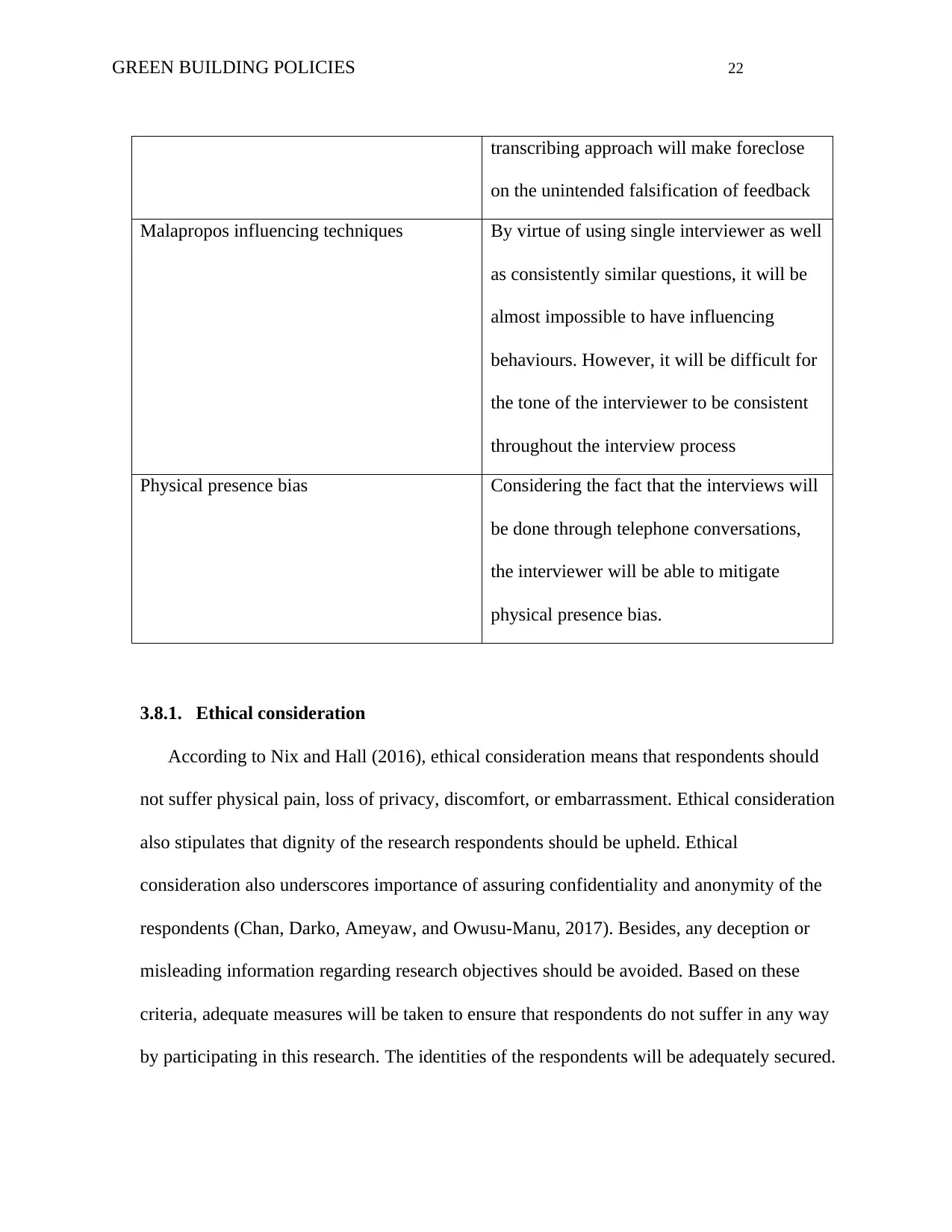
GREEN BUILDING POLICIES 22
transcribing approach will make foreclose
on the unintended falsification of feedback
Malapropos influencing techniques By virtue of using single interviewer as well
as consistently similar questions, it will be
almost impossible to have influencing
behaviours. However, it will be difficult for
the tone of the interviewer to be consistent
throughout the interview process
Physical presence bias Considering the fact that the interviews will
be done through telephone conversations,
the interviewer will be able to mitigate
physical presence bias.
3.8.1. Ethical consideration
According to Nix and Hall (2016), ethical consideration means that respondents should
not suffer physical pain, loss of privacy, discomfort, or embarrassment. Ethical consideration
also stipulates that dignity of the research respondents should be upheld. Ethical
consideration also underscores importance of assuring confidentiality and anonymity of the
respondents (Chan, Darko, Ameyaw, and Owusu-Manu, 2017). Besides, any deception or
misleading information regarding research objectives should be avoided. Based on these
criteria, adequate measures will be taken to ensure that respondents do not suffer in any way
by participating in this research. The identities of the respondents will be adequately secured.
transcribing approach will make foreclose
on the unintended falsification of feedback
Malapropos influencing techniques By virtue of using single interviewer as well
as consistently similar questions, it will be
almost impossible to have influencing
behaviours. However, it will be difficult for
the tone of the interviewer to be consistent
throughout the interview process
Physical presence bias Considering the fact that the interviews will
be done through telephone conversations,
the interviewer will be able to mitigate
physical presence bias.
3.8.1. Ethical consideration
According to Nix and Hall (2016), ethical consideration means that respondents should
not suffer physical pain, loss of privacy, discomfort, or embarrassment. Ethical consideration
also stipulates that dignity of the research respondents should be upheld. Ethical
consideration also underscores importance of assuring confidentiality and anonymity of the
respondents (Chan, Darko, Ameyaw, and Owusu-Manu, 2017). Besides, any deception or
misleading information regarding research objectives should be avoided. Based on these
criteria, adequate measures will be taken to ensure that respondents do not suffer in any way
by participating in this research. The identities of the respondents will be adequately secured.
Secure Best Marks with AI Grader
Need help grading? Try our AI Grader for instant feedback on your assignments.
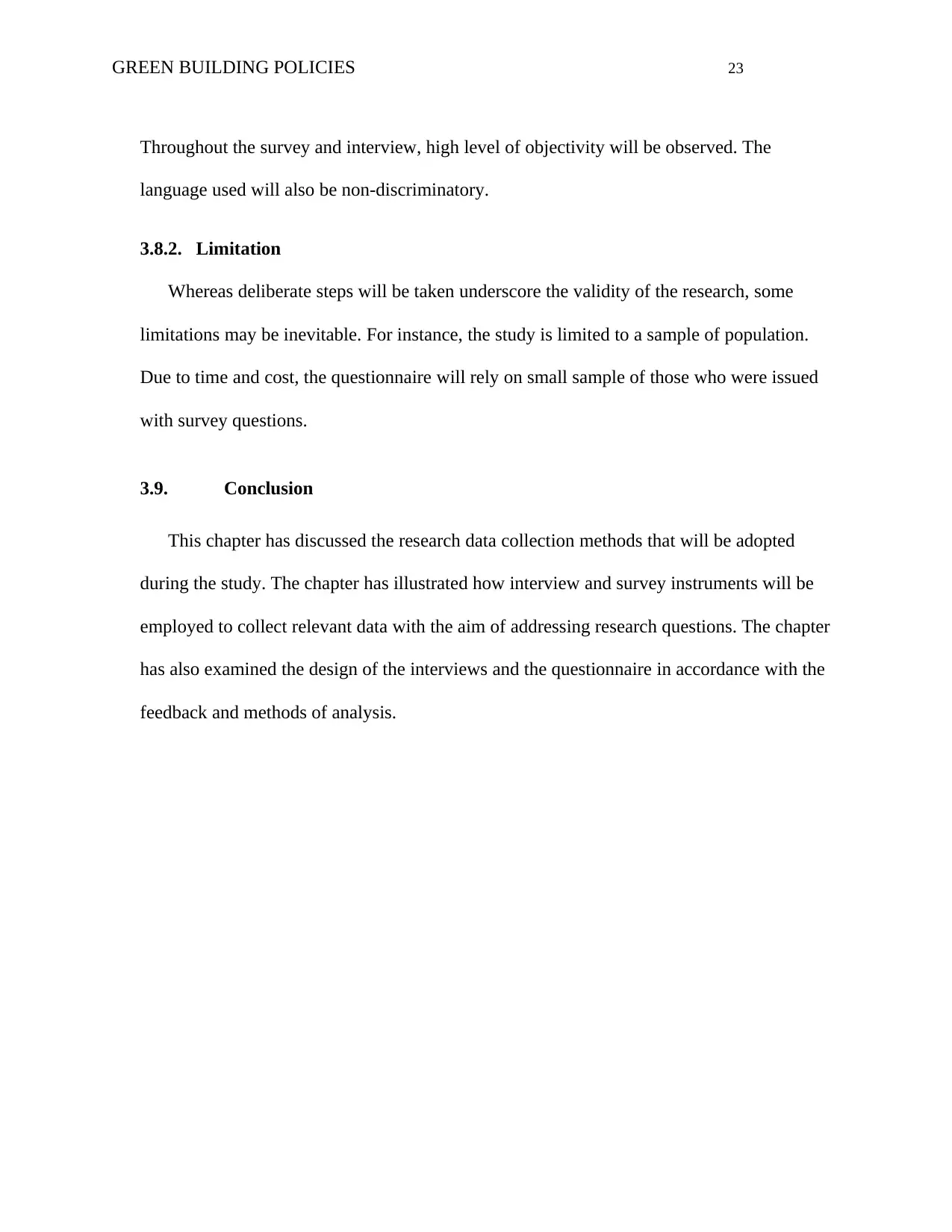
GREEN BUILDING POLICIES 23
Throughout the survey and interview, high level of objectivity will be observed. The
language used will also be non-discriminatory.
3.8.2. Limitation
Whereas deliberate steps will be taken underscore the validity of the research, some
limitations may be inevitable. For instance, the study is limited to a sample of population.
Due to time and cost, the questionnaire will rely on small sample of those who were issued
with survey questions.
3.9. Conclusion
This chapter has discussed the research data collection methods that will be adopted
during the study. The chapter has illustrated how interview and survey instruments will be
employed to collect relevant data with the aim of addressing research questions. The chapter
has also examined the design of the interviews and the questionnaire in accordance with the
feedback and methods of analysis.
Throughout the survey and interview, high level of objectivity will be observed. The
language used will also be non-discriminatory.
3.8.2. Limitation
Whereas deliberate steps will be taken underscore the validity of the research, some
limitations may be inevitable. For instance, the study is limited to a sample of population.
Due to time and cost, the questionnaire will rely on small sample of those who were issued
with survey questions.
3.9. Conclusion
This chapter has discussed the research data collection methods that will be adopted
during the study. The chapter has illustrated how interview and survey instruments will be
employed to collect relevant data with the aim of addressing research questions. The chapter
has also examined the design of the interviews and the questionnaire in accordance with the
feedback and methods of analysis.

GREEN BUILDING POLICIES 24
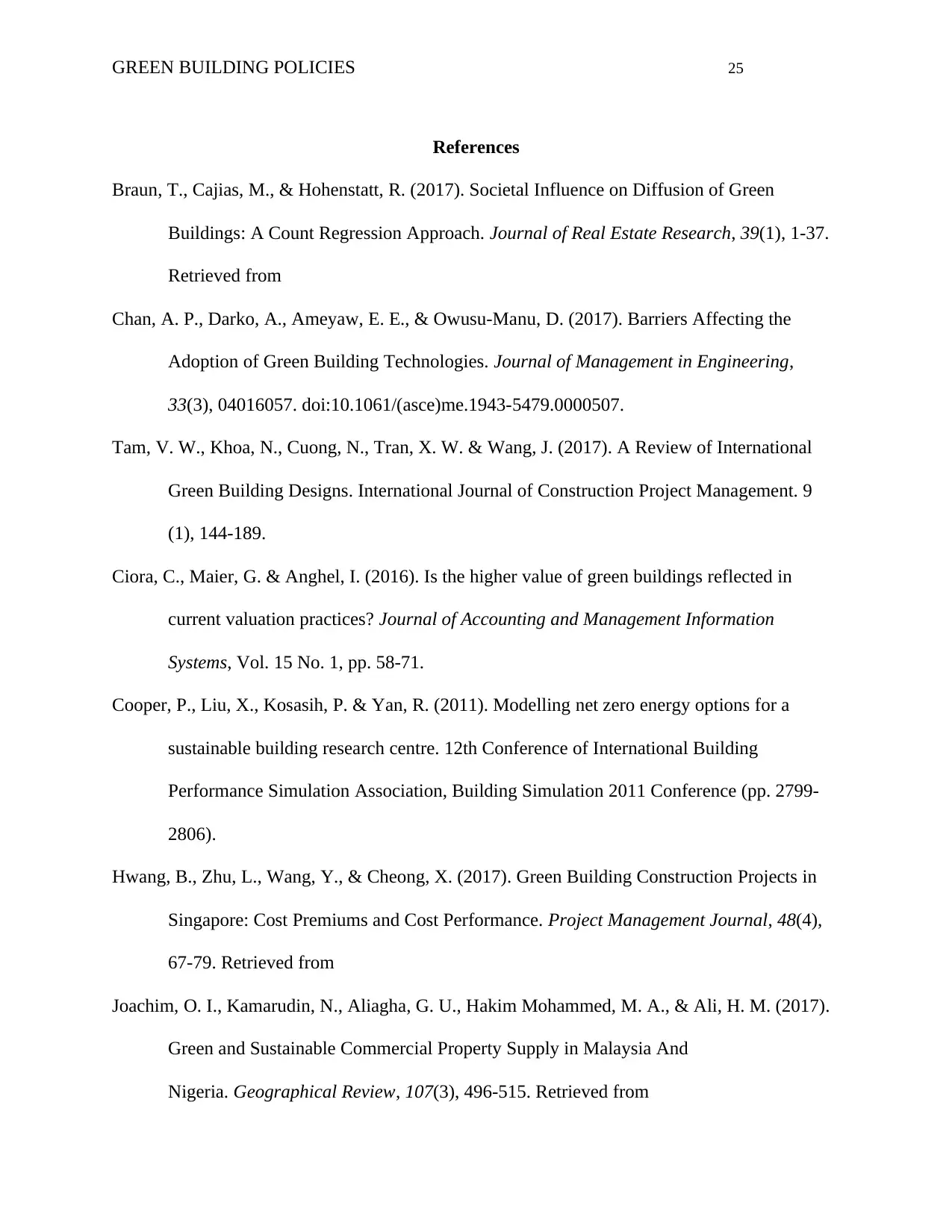
GREEN BUILDING POLICIES 25
References
Braun, T., Cajias, M., & Hohenstatt, R. (2017). Societal Influence on Diffusion of Green
Buildings: A Count Regression Approach. Journal of Real Estate Research, 39(1), 1-37.
Retrieved from
Chan, A. P., Darko, A., Ameyaw, E. E., & Owusu-Manu, D. (2017). Barriers Affecting the
Adoption of Green Building Technologies. Journal of Management in Engineering,
33(3), 04016057. doi:10.1061/(asce)me.1943-5479.0000507.
Tam, V. W., Khoa, N., Cuong, N., Tran, X. W. & Wang, J. (2017). A Review of International
Green Building Designs. International Journal of Construction Project Management. 9
(1), 144-189.
Ciora, C., Maier, G. & Anghel, I. (2016). Is the higher value of green buildings reflected in
current valuation practices? Journal of Accounting and Management Information
Systems, Vol. 15 No. 1, pp. 58-71.
Cooper, P., Liu, X., Kosasih, P. & Yan, R. (2011). Modelling net zero energy options for a
sustainable building research centre. 12th Conference of International Building
Performance Simulation Association, Building Simulation 2011 Conference (pp. 2799-
2806).
Hwang, B., Zhu, L., Wang, Y., & Cheong, X. (2017). Green Building Construction Projects in
Singapore: Cost Premiums and Cost Performance. Project Management Journal, 48(4),
67-79. Retrieved from
Joachim, O. I., Kamarudin, N., Aliagha, G. U., Hakim Mohammed, M. A., & Ali, H. M. (2017).
Green and Sustainable Commercial Property Supply in Malaysia And
Nigeria. Geographical Review, 107(3), 496-515. Retrieved from
References
Braun, T., Cajias, M., & Hohenstatt, R. (2017). Societal Influence on Diffusion of Green
Buildings: A Count Regression Approach. Journal of Real Estate Research, 39(1), 1-37.
Retrieved from
Chan, A. P., Darko, A., Ameyaw, E. E., & Owusu-Manu, D. (2017). Barriers Affecting the
Adoption of Green Building Technologies. Journal of Management in Engineering,
33(3), 04016057. doi:10.1061/(asce)me.1943-5479.0000507.
Tam, V. W., Khoa, N., Cuong, N., Tran, X. W. & Wang, J. (2017). A Review of International
Green Building Designs. International Journal of Construction Project Management. 9
(1), 144-189.
Ciora, C., Maier, G. & Anghel, I. (2016). Is the higher value of green buildings reflected in
current valuation practices? Journal of Accounting and Management Information
Systems, Vol. 15 No. 1, pp. 58-71.
Cooper, P., Liu, X., Kosasih, P. & Yan, R. (2011). Modelling net zero energy options for a
sustainable building research centre. 12th Conference of International Building
Performance Simulation Association, Building Simulation 2011 Conference (pp. 2799-
2806).
Hwang, B., Zhu, L., Wang, Y., & Cheong, X. (2017). Green Building Construction Projects in
Singapore: Cost Premiums and Cost Performance. Project Management Journal, 48(4),
67-79. Retrieved from
Joachim, O. I., Kamarudin, N., Aliagha, G. U., Hakim Mohammed, M. A., & Ali, H. M. (2017).
Green and Sustainable Commercial Property Supply in Malaysia And
Nigeria. Geographical Review, 107(3), 496-515. Retrieved from
Paraphrase This Document
Need a fresh take? Get an instant paraphrase of this document with our AI Paraphraser
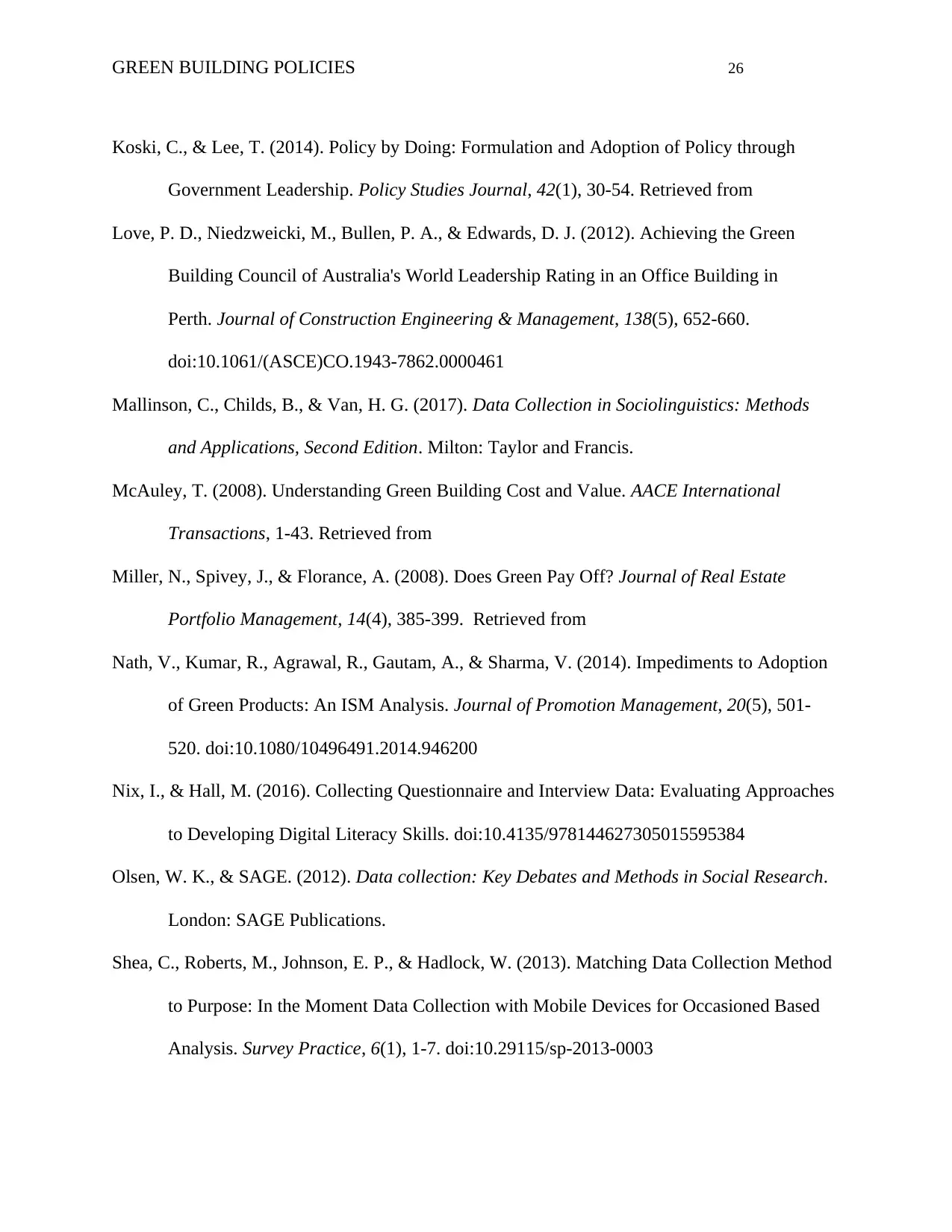
GREEN BUILDING POLICIES 26
Koski, C., & Lee, T. (2014). Policy by Doing: Formulation and Adoption of Policy through
Government Leadership. Policy Studies Journal, 42(1), 30-54. Retrieved from
Love, P. D., Niedzweicki, M., Bullen, P. A., & Edwards, D. J. (2012). Achieving the Green
Building Council of Australia's World Leadership Rating in an Office Building in
Perth. Journal of Construction Engineering & Management, 138(5), 652-660.
doi:10.1061/(ASCE)CO.1943-7862.0000461
Mallinson, C., Childs, B., & Van, H. G. (2017). Data Collection in Sociolinguistics: Methods
and Applications, Second Edition. Milton: Taylor and Francis.
McAuley, T. (2008). Understanding Green Building Cost and Value. AACE International
Transactions, 1-43. Retrieved from
Miller, N., Spivey, J., & Florance, A. (2008). Does Green Pay Off? Journal of Real Estate
Portfolio Management, 14(4), 385-399. Retrieved from
Nath, V., Kumar, R., Agrawal, R., Gautam, A., & Sharma, V. (2014). Impediments to Adoption
of Green Products: An ISM Analysis. Journal of Promotion Management, 20(5), 501-
520. doi:10.1080/10496491.2014.946200
Nix, I., & Hall, M. (2016). Collecting Questionnaire and Interview Data: Evaluating Approaches
to Developing Digital Literacy Skills. doi:10.4135/978144627305015595384
Olsen, W. K., & SAGE. (2012). Data collection: Key Debates and Methods in Social Research.
London: SAGE Publications.
Shea, C., Roberts, M., Johnson, E. P., & Hadlock, W. (2013). Matching Data Collection Method
to Purpose: In the Moment Data Collection with Mobile Devices for Occasioned Based
Analysis. Survey Practice, 6(1), 1-7. doi:10.29115/sp-2013-0003
Koski, C., & Lee, T. (2014). Policy by Doing: Formulation and Adoption of Policy through
Government Leadership. Policy Studies Journal, 42(1), 30-54. Retrieved from
Love, P. D., Niedzweicki, M., Bullen, P. A., & Edwards, D. J. (2012). Achieving the Green
Building Council of Australia's World Leadership Rating in an Office Building in
Perth. Journal of Construction Engineering & Management, 138(5), 652-660.
doi:10.1061/(ASCE)CO.1943-7862.0000461
Mallinson, C., Childs, B., & Van, H. G. (2017). Data Collection in Sociolinguistics: Methods
and Applications, Second Edition. Milton: Taylor and Francis.
McAuley, T. (2008). Understanding Green Building Cost and Value. AACE International
Transactions, 1-43. Retrieved from
Miller, N., Spivey, J., & Florance, A. (2008). Does Green Pay Off? Journal of Real Estate
Portfolio Management, 14(4), 385-399. Retrieved from
Nath, V., Kumar, R., Agrawal, R., Gautam, A., & Sharma, V. (2014). Impediments to Adoption
of Green Products: An ISM Analysis. Journal of Promotion Management, 20(5), 501-
520. doi:10.1080/10496491.2014.946200
Nix, I., & Hall, M. (2016). Collecting Questionnaire and Interview Data: Evaluating Approaches
to Developing Digital Literacy Skills. doi:10.4135/978144627305015595384
Olsen, W. K., & SAGE. (2012). Data collection: Key Debates and Methods in Social Research.
London: SAGE Publications.
Shea, C., Roberts, M., Johnson, E. P., & Hadlock, W. (2013). Matching Data Collection Method
to Purpose: In the Moment Data Collection with Mobile Devices for Occasioned Based
Analysis. Survey Practice, 6(1), 1-7. doi:10.29115/sp-2013-0003
1 out of 26
Related Documents
Your All-in-One AI-Powered Toolkit for Academic Success.
+13062052269
info@desklib.com
Available 24*7 on WhatsApp / Email
![[object Object]](/_next/static/media/star-bottom.7253800d.svg)
Unlock your academic potential
© 2024 | Zucol Services PVT LTD | All rights reserved.




